#these two are the strongest characters in the saga
Text
A Goodbye to The Bad Batch
I don’t even know what to say first. Because this is goodbye, but it is also everything but. But I suppose I should start at the beginning.
Just a couple of years ago I found my love for Star Wars. My entire life, as far back as I can remember, my dad has tried to get me into the fandom. Now, he’s not a fan the exact same way some of us are, he’d only watched the saga and the Mandalorian, funnily enough I was the one to introduce him to The Clone Wars and beyond, but it’s been a joy in his life for a very long time. I was never interested in it when I was little, but then I got a little older and Star Wars started to capture my interest.
One random weekend, I believe in 2021 or 2022, I decided that I was going to watch all nine saga movies in those forty-eight hours, and then start on my goal to watch every show and the additional movies.
This is, without a shred of doubt, one of the greatest decisions I have ever made, and one that I will never regret. I would not be the person I am had I not given Star Wars a chance.
It would sound ridiculous to anyone anywhere else, but this has become such a safe place for me that I know I can be honest.
Everyone finds that one thing that makes them happy like nothing else. A person, a hobby, a place, a fandom. Mine is the galaxy far, far away that lets me escape from my life whenever I need to.
The Star Wars fandom has its faults, and there is so much hatred.
But more than anything, there is love like no love I have ever experienced before. The love between fans and our love for these movies and shows is something I never expected to have in my life. But somehow, for some reason, it has all found a permanent place in my heart, and I couldn’t be happier.
At this time, the first season of The Bad Batch had just been released. I was branching out, watching The Clone Wars and then jumping to The Book of Boba Fett, though I’m not sure why I chose to watch everything in such a completely random order.
But then I started The Bad Batch.
I had no idea what Crosshair, Tech, Wrecker, Hunter, Echo, and Omega would come to mean to me.
I have dealt with a lot in the last few years. Nothing compared to others, but depression finds a way to wedge into your life. I love to be alone, but I don’t like to be lonely, and I have managed to isolate myself to a point of misery.
I found more comfort in The Bad Batch than anything else in my life, and I will never forget the joy The Bad Batch brought me in these last few years.
I began to write when I found Star Wars, and I was inspired to do so by The Bad Batch. Before, I had never felt so compelled by any one piece of media to add my own part of it to the world, until this. Writing has become another escape, one that gives me an outlet to continue the stories of characters left behind.
What I already knew has been reaffirmed, the lessons I have learned remain with me, and will even after this is over.
That it’s okay to feel afraid, because everyone does, and to make mistakes, provided you learn from them.
That feeling out of place for one reason or another does not make you unworthy of love, and having limitations with affection isn’t something you need to apologize for.
That being goofy, having fun, finding joy in the dark places, is just as vital a part of life as anything else, if not what we need more than anything.
That taking time for yourself, to make sure you don’t fall apart, even while taking care of others, is important.
That our worst moments can be one of two things, what consumes us, or what we grow from.
That being a young woman is not a detriment to your worth, intelligence, talent, or any other aspect of life, but is in fact what makes you strongest.
That what makes us unique and our faults are a part of who we are, but they do not define us, and we are so much more than the ideas people have of us.
My only regret is not making friends when I had the chance. I’m bad at that, opening up and putting myself out there, and I shy away from talking to new people because it makes me uncomfortable. But I wish I had been able to put that aside before it was too late and found people who love The Bad Batch the way I do to continue talking to, even after the show ends.
But to all the people who have supported me and who I have supported, thank you for being part of my Bad Batch experience.
It's very difficult to believe that this is it.
Though The Bad Batch has not been around long, it feels like it has, because as long as I have been watching Star Wars, The Bad Batch has been in its active run, and I’m so grateful I got to be here when it was.
I know that even when the credits roll for the final time, when the greater fandom forgets the show that they never really understood the way we have, I’ll be here, and hopefully, so will all of you. I think that the family brought together by The Bad Batch will endure, even if we go quiet for a while.
We’ll stick around, for the day the Batch comes back. Because I know they will.
Thank you Clone Force 99, the Bad Batch fandom, Dee Bradley Baker, Michelle Ang, the Kiners, and everybody who played a part in telling this story.
The impact The Bad Batch has had on my life has been profound, and I wouldn’t give it up for anything. It’s been a wild ride, and I have enjoyed every second of it. It has been a privilege to be a part of this piece in the ever growing history that makes up Star Wars.
Goodbye, Bad Batch. Until next time.
“Change takes getting used to. You’ll see. Just give it time.”
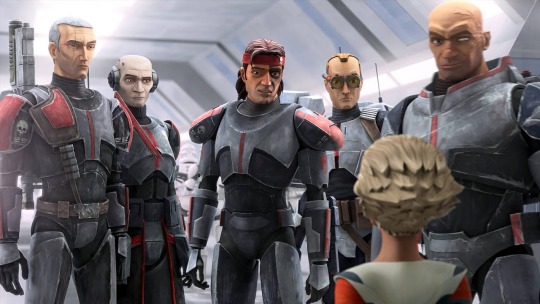
#star wars#the bad batch#tbb#star wars the bad batch#sw tbb#star wars tbb#sw the bad batch#the bad batch season 3#tbb crosshair#crosshair tbb#crosshair bad batch#tbb tech#tech tbb#tech bad batch#tbb wrecker#wrecker tbb#wrecker bad batch#tbb hunter#hunter tbb#hunter bad batch#tbb echo#echo tbb#echo bad batch#tbb omega#omega tbb#omega bad batch
86 notes
·
View notes
Text
Yu-Gi-Oh GX and Alchemy: The Nigredo

So Yu-Gi-Oh GX is the first successful Yu-Gi-Oh spinoff after the original manga and anime ended, and it began two trends, one a long line of anime spinoffs that would continue to make anime original stories revolving around the trading card game and two that each new anime would focus on a new method of special summoning.
When creating an all new Yu-Gi-Oh story with only some input from the original mangaka, Hikokubo Masashiro stated GX focusing on fusion summons was an idea the staff came up with. Hikokubo felt that polymerization and fusion summoning were rarely used during the duel monsters era, and felt that it was a very underutilized but incredibly interesting mechanic that was unique to Yu-Gi-Oh! When he proposed the idea to have the new summoning be fusion focused, Takahashi loved the idea and was extremely enthused by it.
Now the question before we even begin is why am I analyzing Yu-Gi-Oh? It's because it's a shonen anime and this is the blog where we overanalyze shonen.
Yu-Gi-Oh is literally no different from any anime with a power system, it's like Hunter x Hunter except instead of using an ovceromplicated nen system with a lot of rules, the characters instead play an overcomplicated card game with a lot of rules. The same way a character's nen is thematic and telling of their character in Hunter x Hunter, their cards and dueling style is thematic to them in Yu-Gi-Oh! If you can just get over the fact that it's kind of silly everyone's using cards to fight, it's the same as any other shonen anime. They're all using magic cards to fight each other with magic, the cards are a power system, and the power system means something in regards to the characters in a shonen anime.
By Yu-Gi-Oh GX using fusion as its focus summoning method (combining two or more monsters to summon one) it's also thematically about alchemy - specifically physical alchemy solve et Cogaula. Latin for dissolve and coagulate, the process in which through four elemental stage silver is refined into gold and a philosopher stone is created.
The main character of Yu-Gi-Oh GX is also on a journey to become an alchemist, and create the philosopher's stone / the elixirof life. He is also a duelist who uses an archetype known as the "elemental heroes" that fuses heroes based off the four elements (fire, earth, water, air) and also yin and yang (light and darkness) into different combinations to create stronger monster. A character who's strongest card at the end of the first season is called "Elemental HERO Elixir" and requires featherman (wind), burst lady (fire), clayman (earth), and bubbleman (water) to fuse together in order to summon. A character who's art depicts a man wearing gold armor surrounded by the four elements of the Yu-Gi-Oh cardgame in the background.

However, that's only in season 1 and Judai's journey stretches for four seasons. I only used elixir as an example to show that fusion and the elemental hero archetypes are both things that connect Judai to alchemy, and why his journey is to complete the four stages of alchemy and the creation of the philosopher's stone.
I'm also making this post for Kate who is the only person that will read it that Yu Gi Oh GX incorporates Alchemy research as well as A Song of Ice and Fire and RWBY. Because just as with those shows the formula of "Solve et coagula" is stuck to, though Yu Gi Oh GX uses "Fusion" as its main metaphor for dissolve et coagula.
Anyway, Yu Gi Oh GX has four seasons, with four main story arcs which follow the four stages of Alchemy to a T.
The Seven Star Saga: Nigredo
Society of Light Saga: Albedo
Dimmension World Saga (Citrinitas)
Darkness Saga: Rubedo (Red)
These four stages also proceed in order of four elements, which as I said is the same as the four elements of monster cards in Yu Gi Oh.
Fire
Water
Earth
Air
They also all correspond to four colors as long as we're getting the basics out of the way, because color symbolism is important to aclhemy too. These are:
Nigredo / Black
Abledo / White
Cintrinitas / Yellow
Rubedo / Red
For more proof that Alchemy is baked into the DNA of this show, here's a group shot of what are basically the main characters for opening two, and look what colors they are wearing.

Judai - Red / Black
Fubuki Tenjoin and Asuka Tenjoin - White
Manjoume - Black
Sho, Misawa, Kenzan - Yellow
There's also three main dorms Osiris red, Ra Yellow, Obelisk Blue and yes Obelisk Blue is Blue but the uniforms are Blue and White and they're even replaced by the white dorm in the second season. Characters even change what colors they are wearing to indicate progression in their arc, Fubuki is introduced to us as Darkness possessed by his inner darkness and then switches to an all-white uniform by season 2 nigredo -> albedo. Manjoume sheds his blue uniform for Black and stays in the Osiris Red dorm for three seasons after losing his elitism -> entering the nigerdo stage.
Most importanly though Judai our alchemist is the only character to wear red and black, as Red is the color of the philosopher's stone which is Judai's main goal but Judai like Manjoume also wears black underneath to signifiy he too is going through the nigredo stage. Judai is an alchemist attempting the great work of self, and he must start at stage one - Nigredo.
So, to begin with what is Nigredo?
The Alchemy of Darkness - Nigredo
In alchemy, nigredo, or blackness means putrefacation or decomposition. Many alchemist believe that as a first step in the pathway to the philosopher's stone all alehmical ingredients need to be cleansed and cooked into a uniform black mater. This is sometimes called "blacker than the blackest black>" Nigredo means putrefecation and decomposition.
It's ruled by the planet Saturn and connected to lead, which is ocnsidered to be the basest and most impure metal. Metaphysically, it is tied to the dragon and the destruction of the dragon, symbolized by decapitation and the skull of the raven.
This is an unpleasant and often violent process, because one must face one's darkest flaws. Because one 'reaps what ones sows" and noen gains likel only to what one loses accoring to the Laws of Isis spoken by the Angel Amnael, to change into a final nature one must destroy its flaws - and thus its whole property - so that it might be remade again. In a lab one must cook all components down to a uniform black matter, which takes no less than fourty days - or one year of high school.
Judai begins his journey wearing inverted colors, black school uniform on the outside and red on the inside. He also is marked in the first episode and season 2 as the Fool. Saio a character with the ability to see the future who plays a tarot themed deck, sees Judai as the fool, the wildcard in which fate can change.
The fool's journey, and the process of alchemy are similiar, they're both things Jung references for the development of the self. Tarot is season 2 territory so all you need to know right now is Judai is the fool in both senses of the word, he is at once innocent and ignorant. His innocence inspires people, and his ignorance causes problems, though that won't be highlighted until season 3. The fool is on a journey to gain wisdom, which is why Judai's first action in the anime is meeting up with a magician (Yugi, who's ace card is the black magician) who gives him guidance by giving him winged kuriboh.

The story of the Tarot is actually a paralel to the alchemist's journey, and the Fool--who begins his trek untouched by the world around him because he sees and understands nothing--is the fledgling alchemist, with his powers and potentials all untapped and unknown. This is a childlike figure in many ways, and the symbolism here is capable of being both that of innocent oblivion and the callous disregard that children (and Judai) are also so capable of. In fact Judai's entire character revolves around the dual faces of the fool, that innocence and ignorance can be the same thing, and that jUdai may not mean harm in his ignorance but that doesn't mean it's not harmful and his ignorance is why he needs to go on a quest for knowledge in the first place.
And Yu-Gi-Oh GX is primarily about Judai's journey. There are other characters who grow up besides Judai, but it is primarily about Judai going on a journey from childhood into adulthood. I will be mentioning other characters here, but when they change it's usually meant to reflect Judai in a way too.
Either way, Judai's role as the alchemist is indicated right away in his first duel, as he uses flame wingman - his favorite card a fusion monster that is specifically a fusion between man (featherman) and woman (burst lady) in order to cook crowler's antique gear soldier which is made of metal. This not only sets up the formula for how he'll win every major duel in the show, fuse weaker monsters into stronger mosnters. It also serves as some early, early foreshadowing for the appearance of the Rebis the fusion of man and woman that happens in the final stage of alchemy. The Rebis in this case being Yubel but that's season 3 territory.
Flame Wingmna's appearance is foreshadowing for Yubel, it's also pretty clearly a Rebis, it's a fusion of a featherman and burst lady, and it also has a dragon head appearaing on one of its arms. It's also the first succesful fusion / attempt at alchemy we see Judai perform in the show and it's what lets him win his first duel. It even appears in front of the moon because Judai played Skyscraper, switching the time in the duel from night to day.


However, alchemy doesn't just happen once. It's a process of continual refinement where the alchemist dissolves and coagulates over and over again in order to purify himself, the same way that Judai's entire sidedeck is countless different attempted fusions of his elemental hero monsters, each fusion serving a purpose in a different situation.
Chemical weddings, the union of opposite elements don't happen once in this show but over and over again. This is important to point out for all three seasons to show how much alchemy symbolism happens in this show and how much alchemy is a continual process.
The Stages of Alchemy
However, before continuing forward I need to say Yu Gi Oh GX is a pretty weirdly paced show, the first 100 episodes or so are setup for a dark deconstruction that happens in the next 90 after that. So Season 1 and Season 2 are both a lot of set up for both changes and alchemical processes that will happen mainly in Seasons 3 and 4. Which as I said, chemical weddings happen multiple times not just once and alchemy may have stages but it's not necessarily a strictly linear process. The series however does still follow the 4-part structure of alchemy and even makes specific references to medieval paintings which describe the alchemical processes.
There are also several allusions to the Splendor Solis - 22 illustrated plates which describe the alchemical process [source]
Which are divided into 4 groups like this:
4 introductory plates - they present the protagonists of the alchemical journey.
7 Parables - they describe the alchemical death and rebirth
7 flaks plates - they describe the alchemical process from a practical point of view
4 final plates - they describe the alchemical process from a spiritual point of view.
Seasons 1 and 2 being one long introduction for the second half of the anime, both include references to the four introductory plates. We'll be covering references to those two as we continue our journey into season 1.
I bring this up now because in episode 3 we are already at our first reference to Splendor Solis, Plate 4 the meeting of the king and the queen, the male and female, the yin and yang, the sun and the moon. The opposition of two equally matched forces, what most call the chemical wedding.

Judai and Asuka in the third episode duel each other over water with both of thme standing on boats. Asuka is the queen of the obelisk blues called that by several characters, and Judai not only quickly becomes the best male duelist in the school he's also on his journey to being a king in season 3. Judai's flame wingman (fire) actually clashes with her Cyber Blader (ice) during the duel atop the water.

Asuka primarily wears white, which is associated with Abledo. She is also associated with water and ice (she uses an ice deck when brainwashed by sartorius in season 2). In Jungian symbolism, the Albedo stage of alchemy is also tied to the union of anima and animus. There will be more time to cover this in my season 2 meta, but just as a starter Asuka in this episode is basically set up to be a female Judai, something compounded upon later in the season.
The basic premise of this episode is that Cronos puts a fake love note from Asuka to Judai in order to try luring Judai into a trap to visit the girl's dorm at night. When Sho gets lured by the trap, Asuka thinking very much like Judai does, doesn't see a potential romantic partner but a potential duel rival.
Asuka's true love isn't boys, but dueling itself much like Judai who for the first two seasons seems either oblivious or weirded out by women showing affection for him and who's primary method of making friends and connecting to people is by dueling others.
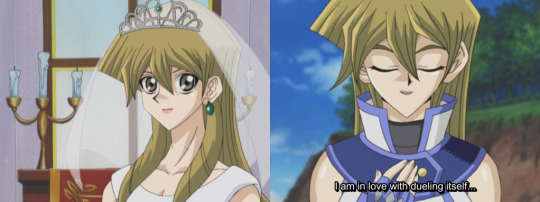
Judai and Asuka's first meeting isn't necessarily a romantic chemical wedding, because one happens in season 3 and it's with someone who's not Asuka - but it is still a union of opposites. Anima and Animus is something I plan to cover more in season 2 but basically Jung divides the psyche into two part, the feminine aspects of personality and the masculine aspects and makes the observation that most men aren't accustomed to their feminine side and vice versa. Men must therefore come into touch with their feminine side and integrate their feminine traits into their everyday life in order to become fully realized people.
Judai is basically dueling with the female version of himself, another person who loves dueling above everything else and uses it as a way of conencting with other,s and Asuka even pulls a Judai-like move, she threatens to get Judai and Sho expelled to extort a duel out of Judai because she wanted to size him up as a potential dueling rival.
Asuka also plays the role of the high priestess in the fool's journey, to Yugi's magician. As it's through his encounter with Asuka that Judai gains passive guidance for what his role will be in season 1 - as she's the one actively looking for her brother Fubuki which will lead Judai to the seven stars plotline. In fact, while Judai came to the anbadoned dorm because him and Sho were sharing scary stories, he sticks around and explores it deeper specifically because he heard Asuka make a mention that her brother went missing there.

This leads to the introduction of shadow duels - duels where characters bet their souls on the line and the consequence for losing is being consumed by darkness, otherwords a failure in alchemy.
The entirety of season one is basically one long pattern of Judai who only duels for fun and to connect to other people learning that there are darker sides to dueling (shadow games) and going through one long process of realizing that not everything is for fun and there are times you duel with your life on the line. Or at least, that's what he should be doing but a lot of Judai's development is stalled until season 3. However, that stage is still set up here.
Judai does not really grow a lot in season one, but we have other characters going through their own mini-alchemeical journeys in order to reflect Judai. For instance, each season Judai has a rival / foil that contests with him for the hero role. In season 1 it's Manjoume who thinks he's the one more set up to inherit the next king of games.
Manjoume goes through a pretty common arc for shonen characters. He's suddenly defeated by the appearance of a new rival, he loses all confidence in himself, he goes off somewhere else to train and then returns to defeat the rival that knocked him off his pedestal.
However, that usually happens to protagonists. Manjoume, a rival character, goes through more of a journey than the main character of his own show at least in season 1. Manjoume follows the nigredo formula pretty much to a T.
We see Manjoume break down completely. He loses to Judai even after getting cards from Crowler (his Dragon card is even killed by Judai) he then has a mental breakdown and tries to cheat against Misawa only to lose again and leave the school entirely. Even his deck goes through the process of dissolve and coagulate, as he has to get rid of his old deck and then find 40 new cards in the northern tundra and put together a new deck from scratch. He even returns to Duel Academy wearing black and purple after having gone through the process of breaking down entirely and reforming to signify his change in the nigredo stage.
This is the kind of arc and internal struggles you give your main character so we find their growth and journey compelling, but Judai's basically already a dueling prodigy he doesn't need to become stronger as a duelist. In fact Manojoume's internal insecurities are more at focus in this arc than the main character's too.

Judai is usually the character who duels the main boss, but in season 1 and 2 he rarely if ever feels the pressure to win the same way that Manjoume does in just this one duel with relatively little stakes. In fact if alchemy especially nigredo requires boiling and pressure in order to change the chemical composition of the metal that they're currently boiling, Manjoume is more emblematic of that chemical change -> heat and pressure allowing him to metamorphosize into a new person.

In fact Judai purposefully doesn't talk to Manjoume during this scene because he doesn't feel like there's anything he could say on an emotional level that would help him b/c Judai isn't really mature enough to understand that feeling of responsibility and pressure Manjoume is struggling under - he just tries to work it out in a duel instead.
Season 1 is all about Nigredo, about plunging into darkness but Manjoume who plunges into darkness to find himself and to an extent Asuka who journeys into the darkness to find her brother are the oens who actually experience a change while Judai remains a mostly static character. He is the impetus of change for both of these characters, but he doesn't really change himself just yet.
So Asuka has an exernal objective -> find Fubuki, and Manjoume has an internal flaw -> His insecurity and inferiority complex and both of them need to plunge into darkness in order to remedy these things. Judai doesn't have any objective at all, but because he comes into contact with Asuka and Manjoume he helps Asuka with her quest and Manjoume with his internal insecurity.
From early on Judai despite literaly fighting with a deck called the "Elemental Heroes" is more of a designated hero, then an actual hero. As I pointed out above other characters struggle with the kind of insecurities that protagonists usually struggle with. Judai doesn't need to learn to believe in himself or be a better duelist, he's already a dueling prodigy, that's Sho, and Manjoume's struggles. Asuka is the one who has a personal motivation to save someone because she wants to save her brother, Judai only helps because he wants to help Asuka. Judai is picked to fight once the seven stars start appearing not because he is the most heroic character, but because he is the best duelist.
It's not that Judai doesn't help when someone asks him for a helping hand. He always gives his help when asked for it, but otherwise he's an incredibly passive character who continually "only duels for fun" even when the stakes get higher. He only feels the pressure to win that Manjoume did for one episode after the gauntlet of Darkness Camula and even then it's immediately resolved with a duel against Kaibaman.
However, despite not having the things usual main character have, an outward objective, or an obvious internal flaw that he needs to fix or boil away in the alchemy sense he's still the central character of the show. Fubuki is Asuka's brother, and yet when he appears again it's Judai who duels him.
Yami no Game - Versus Darkness
The first instance of actual plot in this show happens in episode 29 (Yu Gi Oh is a well paced show / sarcasm) when Fubuki / Darkness appears as a member of the seven stars, to challenge Judai for his key, kidnapping his friends and holding them hostage in a volcano for an ante. This entire duel is steeped with alchemy symbolism and is to be honest one of my favorite in the series. It's also Judai's first real "yami no game" if one counts the duel at the dorm and the duel against Jinzo as warmups.
To recap from above, Nigredo is the first step of alchemy, it's usually associated with fire, the color black, and the death of a dragon. This duel takes place in a volcano. A volcano where dragons made of flame rise up from the lava, and Judai's opponent Darkness walks right out of the fire to face him.
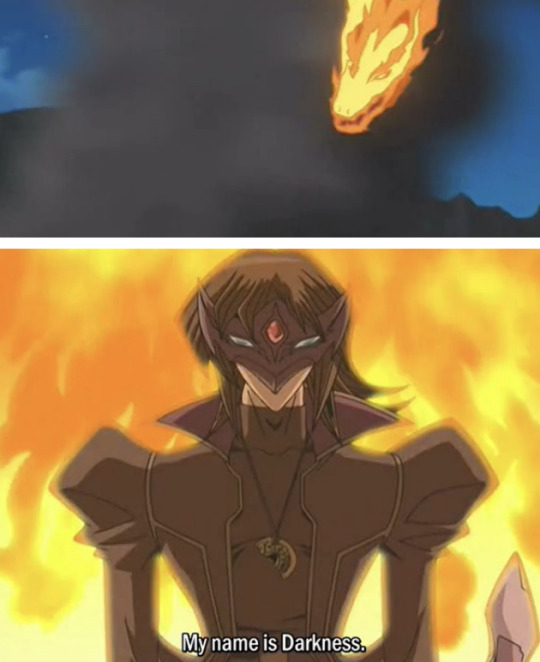
Darkness not only hits all the symbols for the first stage of alchemy, his deck also corresponds to this stage. He's running a red eyes black dragon deck, a deck who's ace monster "Red-Eyes Darkness Dragon" gets stronger for every single monster in your graveyard. If Nigredo is initiated by the death of a dragon. They fight on what is basically a graveyard of dragons with dragon spirits constantly jumping out of the lava, the dead spirits empowering Red Eyes Darkness Dragon even further.
Red Eyes Darkness Dragon - Cannot be Normal Summoned/Set. Must be Special Summoned (from your hand) by Tributing 1 "Red-Eyes Black Dragon". Gains 300 ATK for each Dragon monster in your GY.
Fubuki arrives in practically a storm of fire, promising to melt everything away if Judai doesn't take things seriously. He even calls Judai half-hearted for not realizing what is at stake here. Once again he's applying heat and pressure to try to force a transformation inside of Judai.
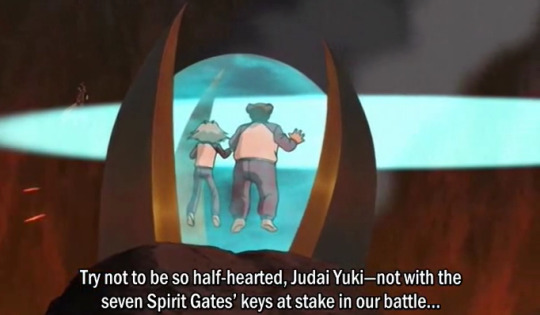
It is the first and last time for awhile someone challenges Judai seriously on this level (as most of the seven star matches bar Camula get kind of silly after this) but it also incorporates the Nigredo and the Work of Self, 'if you cannot overcome the blackness and despair of your own self, you will be burned away'. The volcano, the dragon graveyard, red eyes darkness dragon all incorporate the image of the skull, the dragon and the fire which reduces one to black matter.
In a normal narrative this is where Judai would succumb to the pressure like Manjoume did and start to take things seriously, but once again Yu Gi Oh Gx is building up a three season long-con. The one who changes isn't Judai, but rather Fubuki who's internal darkness is purified by the end and we see him return to his usual self, though he'll call upon the darkness again in season 2 and then season 4 because purification isn't' a one and done process.
We're shown other characters around Judai changing, and Judai often being the impetus for that change, but we're not shown exactly why until all the way in episode 45 when Amnael decides to play his hand, because Yu-Gi-Oh Gx is a well paced show (sarcasm).
If we focus on the duels that develop Judai as a character it goes a little something like:
1st duel against crowler establishes his use of fusion
1st duel against asuka - chemical wedding / anima + animus
1st duel against zane - establishes relationship with sho
3 duels against Manjoume - Manjoume's arc
Judai vs Misawa - More for Misawa's arc because it teaches him that isntinct can win against obsessive thinking over strategy.
Judai's 3 shadow duels (vs Titan, vs. Jinzo, vs. the Gravekeepers)
Finally, vs. Darkness / Fubuki
The only duels that really are about Judai as a character are Yami no Games, the ones where Judai is forced to bet his life on the line in a duel because those are the duels that challenge his philosophy that dueling is just for fun and his desire to duel purely for his own entertainment. Basically every other duel that Judai gets into up until this point is for other characters not him, only the Yami no Games int true Nigredo fashion push Judai's arc along as he slowly realizes there are times where he needs to carry responsibility and weight on his shoulders and keep going.
When the pressure of dueling becomes too much for him after Darkness and Camula he does receive an alchemcial bath, in the form of a hotsprings episode where he gets to fight Kaibaman in a low stakes duel which relieves him of the pressure temporarily. Kaibaman is also dressed in white, and plays the blue eyes white dargon the counterpart to the red eyes black dragon.
The impetus for this episode is a dream where Judai sees himself losing against an unknown shadowy dragon, which causes both of his friends to burn away in fire while he's consumed by the darkness as a price for losing the yami no game.

In those last minutes too Judai's more concerned with his friends who are crying out for his help then he is for the fact that he himself is being consumed by the darkness. Something which will come back in season 3, because Seasons 1 and 2 are excellent at setup and foreshadowing if nothing else.
Foreshadowing because there is a scene where Judai's friends do burn away and he does sink into darkness, his nigrido and all his anxieties reflected in this dream here prove true but once again it happens in season 3.
Things that seem like they are neatly resolved in seasons 1 and 2 will always be called back to in Season 3. Judai goes through several mini arcs of "I need to take dueling more seriously" only to revert back to his usual carefree irresponsible attitude, because in seasons 1 and 2 the consequences for Judai not taking thing seriously and messing up aren't as severe as they'll eventually be.
Judai is called to in his Yami no Games plunge the depths of his own personal darkness, Daitokuji leads him to three shadow games to make him realize there are games where real life people can get hurt - Fubuki yells at the top of his lungs not to half-ass this duel or his friends will burn away into nothing. Judai is called to explore those depths of darkness... he just doesn't. Manjoume does, Fubuki does, Asuka does, even Sho and Ryo have an honest conversation about their relationship as brothers when Camula holds Sho hostage so Ryo will lose the duel.
I'd argue there are hints that Judai does have an inner darkness that he's refusing to examine all the way back in season 1 too, because the foreshadowing in this show is excellent. In episode 5 when they're all sharing ghost stories, Judai shares a story about how he thought he could hear the voices of his duel monsters when he was asleep.

Only for Judai to jokingly end the horror story by declaring that he didn't see a thing.

Those who have watched season 3 know that this is a bald-faced lie, because it was right around that age that Judai was given a haunted card by his father that put all of his friends into comas and made it so no one wanted to duel with him let alone be around him. Judai used to be able to see card spirits, until the traumatic incident of one dark card spirit made him cut off his ability to see them entirely. Judai tells Sho half the story, and then blows the rest off as a joke.
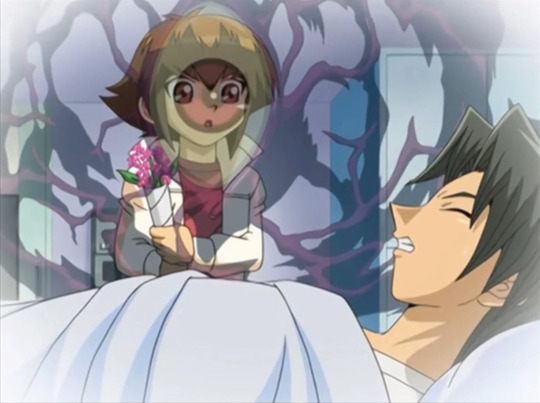
This scene is pretty clear season 3 foreshadowing, but also in a sense of alchemy, Judai is failing to confront the darkness here because he remains ignorant of his repressed childhood memory. He muses for a second on the fact that he can remember hearing card spirits when he was younger, but doesn't reflect on why he stopped hearing them because he's coping poorly with that traumatic childhood incident still. Which is why he is so stagnant because even when he's given opportunities too - he doesn't reflect on his past, or even reflect on who he is whatsoever.
This small detail of his backstory doesn't come until season 3 so technically I'm spoiling you, we're given no information at all in season 1 why Judai loves dueling so much and why it seems to be the only thing he cares about not because the writing is bad but because Judai himself never reflects on those things.
As Judai plunged into the world of Yami no Games, he could have reflected more seriously on these things, but he didn't because Judai is also more concerned with other people, and forced to duel to save other people first before himself.
Judai fails to commit nigredo, and this normally would result in reverse alchemy or even character stagnation but that doesn't happen until season 3 - mainly because in season 1 Judai has a mentor to sweep in and kind of fix his mistakes for him.
There's a whole bunch of duels in between this, but really Judai's next plot relevant duel is episode 44 the Seventh Shadow. When Daitokuji goes missing the gang goes out searching for him, only to find that he's facing Daitokuji as the alchemist Amnael and the sevenths star.
There's a billion alchemy references in this duel, because as I said Judai has only three really plot important alchemy duels this season the first being darkness, the second amnael, and the third Kagemaru and so all the symbolism is frontloaded into this one.
First off, Daitokuji carries around an emerald tablet for a millenium item gifted to him by Kagemaru and he also uses this symbol - which resembles the alchemy symbol for the sun, but also a traditional depiction of an ouroboros a snake eating itself.


The ouroboros a symbol that appeared in alcehmy in Graeco-roman egypt, the same era that the Amneal Story appears from. A symbol which ties to the sun, mercurius (hermes) and his caducous staff which contained a male and female snake interlaced.
In Egypt the sun went on a journey to the underworld every night, only to come back to the world of the living every morning. In the duel itself, Daitokuji is long dead, and Judai must in a way kill his mentor as apprentice in order to replace him as alchemist. Daitokuji also comes right back immediately as a ghost, because life and death are an eternal cycle like the ouroboros itself.
Daitokuji goes by the name of Amnael an angel who appeared before Isis to reveal the great mystery to her. Amnael becomes a lover to Isis and reveals the secret to her, but first makes her swear a mighty oath by "fire and water, like and darkness, by fire, water, air, and earth" and a variety of Greek and Egyptian Deities.
The great secret in question:
“So go then, my child, to a certain laborer named Achaab, and ask him what he has sown and what he has harvested, and you will learn from him that the man who sows wheat also harvests wheat, and the man who sows barley also harvests barley. For a nature rejoices another nature, and a nature conquers another nature.”
In other words the great secret of alchemy is that you reap what you sew. In other words alchemy, like chemical reactions is all about actions and consequences.
This also ties to the phrase "as above, so below" which is chanted constantly in the two episode duel against Daitokuji. A phrase which is on the emerald tablet, (borrowing this from Kate). The emerald tablet is also wielded by hermes, so once again, greco-roman / egyptian alchemy lore.
"That which is above is like to that which is below, and that which is below is like to that which is above."
Things in the macrocrosm are mirrored in the microcosm, or in other words BE THE CHANGE YOU WANT TO BE IN THE WORLD. You have to change yourself before you can change others. The personal change that an alchemist goes through in acquiring the philosopher's stone and finishing a chemical wedding will radiate out to the rest of the world.
This is the role that the master alchemist gives to his apprentice.
Amnael and Judai's duel is basically a crash course of alchemy for dummies. Amnael's card archetype the Alchemy Beasts uses a distillation to summon seven different alchemy beasts which resembles the seven step process of alchemy.
Aretos the time
Ekanos the Mercury
Leon the Lead
Moonface the Silver
Ouoroboros the Bronze
Salamandra the Steel
Golden Homonculus
Coincidentally the number seven shows up a lot this season. The seven stars are the duelists that the main characters have to face in yami no games, probably a reference to the fact that there are seven heavenly bodies in the ancient medieval world, saturn, jupite,r mars, venus, mercury, moon, and sun which also correspond with the seven steps of refining metal into gold listed above. Sun being gold, and again sun being associated with Judai.
While also using support spell cards that reference the nigrido, albedo and rubedo. Before finally using the Macro-cosmos card... which is again covered above changes on the microscale effect the macroscale.
All in the world originates from a single substance altered in various ways to form heaven and earth. Even the world of man known as the microcosmos and the world of the heavens known as the macrocosmos.
So, humans and outerspace are connected?
Amnael then procees to push the sun through three phases, helios - the primordial sun, Helios - Duo Megistus, and Helios - tris magestius. The second stage being a reference to this.

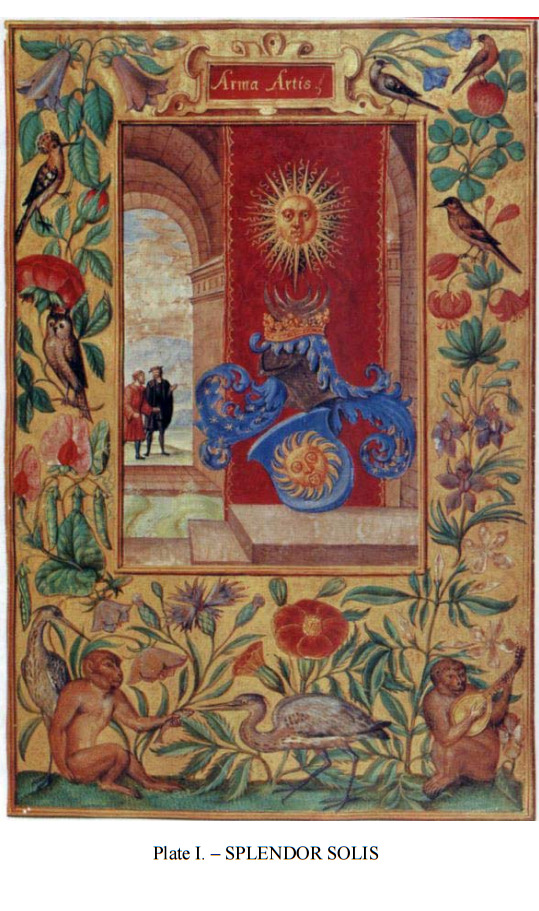
Outside the building where this standard is housed are two men. Their body postures might suggest they are teacher and initiate. The master points to the standard, separated from them by swirling and overflowing waters. There is also a three-step platform leading up to the standard, possibly reflective of the tria prima which all alchemical substances are made from; Paracelsus defined these as Mercury (Spirit), Salt (Body), and Sulfur (Soul)
The master is teaching the student - there are two men, two suns, ad even two babboons in this piece. Sharing and art. Giving and taking. The teacher shares, and the student takes, indicative of the fact this is Daitokuji's final lesson.
In alchemy three suns also appear to show the three stages of aclehmy, the blakckun, white, sun and red sun. The black sun is considered important for the dissolution stage of alchemy. The man holding the flask contianing the golden liquid, made from the four elementsor rather Plate 2 is also referenced in this duel.


Daitokuji is the old man with the flask, the duel also concludes with an elixir created from the four elements of nature. Judai creates elemetal hero elixir by fusing four elemental heroes of different elements in his graveyard. After her reflects upon what he's gained in the past year at Duel Acamdey compared to what he didn't have before - friends.
At which finally Daitokuji elucidates why he chose Judai of all people as his chosen pupil.
"Alchemy 's ability to change all into gold is merely a superficial phenomenon. It's true aim is to change the hearts of people into purer, nobler things."
Judai as we'll find out in season 3 started out the story as a friendless loser, and his desire to connect to others through dueling, causes him to purify the people around him by enduring many trials and tribulations for their sakes.
Amnael is also the first to notice the potential of Judai, and that this potential lies within Judai's darkness. Though, even though Judai is pushed to do a little self reflection in this duel (admitting to himself that he was lonely before he came to duel academy and this is the first time in his life he's had friends) he doesn't actually look inside that darkness towards those repressed childhood memories we were looking at earlier.
If anything while Daitokuji's lesson is a short-term fix, like a bandage over Judai, it doesn't actually help him in the long-run. This is because the reason why Judai is succesful in this season is not really anything of Judai's doing, but because Daitokuji the master rigs it for him. Daitokuji is the one who prepares challenges to increase Judai's strength at dueling, Daitokuji is the one who hands Judai the emerald tablet that lets him make a philosopher's stone during his duel with Kagemaru, Daitokuji is the architect of most of the plot in season 1 and Judai just kind of passively follow his script. Judai is not the alchemist in the first season, he's the apprentice and basically he only makes his first step in his journey by consuming his master and that's in episode 45, when the season is 4/5ths of the way over.
Judai is the alchemist, he's supposed to change others by forming relationships with them the same way that he can fuse two monsters together to form a stronger monster. However, he also has to change himself in order for that to happen and Judai doesn't change through seasons 1 and 2 - he gets by in the short term but it costs him long term development.
Because the duels Judai gets into are always about other people and not about himself. Even the climactic duel of the season against Kagemaru, Judai barely knows who this guy is. Judai's not there by choice, Judai is there because Daitokuji set things up so that his student Judai would defeat Kagemaru the main villain.
Judai's not dueling for himself so we barely learn anything from these duels, and Judai still doesn't really take this duel seriously. The one small thing we get from him is this:

"I feel sorry for you, you can control all the powerful monsters you want, but if you're the one wiping out duel monsters... no one is going to see you as a friend. And that'd make you lonely right? Live as long as you want, but without friends around, it'd just be boring right?"
Which sounds like a pretty shallow statement, but is telling of Judai. Judai had no friends before coming to Duel Academy. Judai gained friends because he was a strong duelist, Sho looks up to him because he's a dueling prodigy like Ryo, Asuka befriended him as a duel rival first, Manjoume only views him as a rival, Ryo sees Judai as someone who's potential for growth surpasses him because Ryo being a perfectionist feels like his perfectionism is stagnant. Judai's only way to connect with people is through duel monsters, and the reason most of these people have an interest in him is because he's a dueling prodigy. Thus, Judai equates dueling with making friends, and believes he has to keep getting into duels like this for the sake of his friends rather than himself.
Judai only wants to duel for fun, but is put into situations where he has to duel with high stakes, because everyone relies on him as the best duelist around, and because he thinks the only reason he made friends in the first place is his skill as a duelist.
Thus, Judai even when forced into these stressful duels, will fall back on his whole "I'm just trying to have fun" thing in order to cope because he's not really here because he wants to but because other people have put him into this situation. Therefore, he doubles down on his own personal enjoyment to convince himself he's here because he wants to and so the pressure doesn't get to him the way he's seen it get to other people like Manjoume.
Judai goes through several trials that seem like Nigredo in season 1. He goes through yami no duels where his life are on the line, challenging his philosophy of only dueling thrilling opponents for fun. He's put through literal trial by fire twice, first by Darkness, then by Daitokuji, situations where he will literally burn away into ash if he doesn't perform. He even duels a Yami no Game with Kagemaru where he forges a philoopsher's stone to create 3 custom cards to win the duel - but once again that's not really Judai who forged it because Daitokuji did it for him.
Daitokuji argues that the true alchemy changes the hearts of other people into nobler, purer things which Judai has arguably done for his friends - but what about his own heart?
Other people around Judai change, and are changed by Judai, but Judai himself for the first two seasons does not change. Even in incredibly plot important duels, and I'm including season 2 as well, because in both cases Kagemaru and Saio Judai wasn't really facing himslf or even a reflection of himself. Kagemaru is Daitokuji's enemy and mess to clean up he passed onto Judai, and Saio is Edo's chilhood best friend who became a victim to the light of destruciton. In both cases Judai swept in to fix things because that's what Judai does, he fights others battles for them because he himself lacks either an internal or external reason to duel - and he doubts his abiltiy to make friends if he didn't go around fixing everyone's problems.
As Above, So Below
It is other characters who go through a Nigrido phase in Season 1. However - their Nigrido phases will be reflected in Season 3. These characters experiencing their own inner turmoils mirror the obstacles that Judai has to face ahead of him.
Asuka
Season 1: Judai helps Asuka searching for her brother who's disappeared into the darkness.
vs.
Season 3: Judai travels into another dimmension to find Johan after he disappears from this world, only to find he's possessed the same way Fubuki is. Judai also blames himself for Johan's disappearance and takes on the burden to save him entrely by himself, like how Asuka leads the search for her brother.

Manjoume
Season 1: Manjoume is completely crushed by his responsibility to always win that his brother's force onto his shoulders.
vs.
Season 3: Judai being told to his face he wont' be able to win because he doesn't carry any burdens or serious responsibilities, because that's what drives people to try hard when they're pushed into a corner. Only for Johan to tell Judai that much like Manjoume is being pressured by both of his brothers, Judai has always had to carry everyone's hopes on his shoulders. When he cant carry them anymore, he has a breakdown that pretty much mirrors Manjoume's season one breakdown word for word.
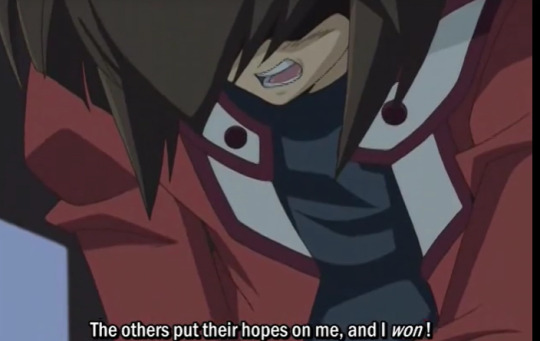
But, even then I won. The others hope their hopes on me, and I won! But still...!! They're all gone. There really was something missing within me. But what is it? What was missing?
Sho
In season one: Judai basically becomes the replacement for Sho's brother, who he has a poor relationship with and Sho has to face his inferiority complex towards his brother head on.
vs.
In season three: Shoe becomes the trigger for Judai's growth when he rejects Judai entirely and stops calling him "aniki" being the last one to abandon him in the dark world when just about everything goes wrong.

But, I guess I thought wrong. Big bro you've just been dueling to satisfiy yourself. You're not my big bro (aniki). You're not my big bro (aniki).
Fubuki
Judai even becomes lost and faces his inner darkness like Fubuki does, the first person to appear before Judai and challenge him to a Yami no Game. Fubuki who was possessed by a dark version of himself who valued power above everything else and then got lost in that darkness.
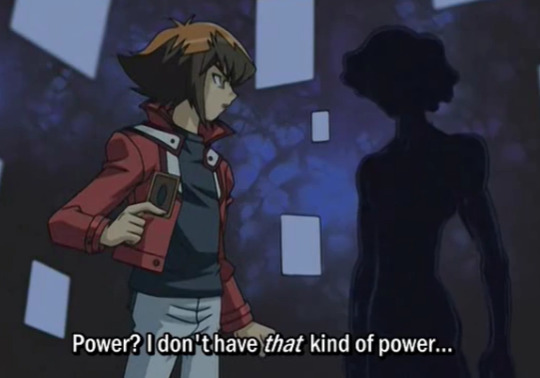
Judai has no arc in season one, and instead helps other characters along in their arcs. However, Judai's inability to change himself or confront his own inner darkness bites him when two seasons later.
Judai's arc then reflects aspects of all of their arcs. Sho's afraid that his brother doesn't love or respect him because he's an inferior duelist to Ryo. Judai loses Sho's love and respect. Asuka has to go on a journey into a darkness to find her loved one and fears Fubuki may never return. Judai repeats that same journey for Johan. Manjoume's cracks under the pressure his brothers put onto him to always win because his family's love is very conditional. Judai finally cracks when he realizes a lot of his friendship was built on the very conditional fact that he had to always win duels for them and fight for other people's hopes and dreams and not his own. In season one Judai cleanses Fubuki's inner darkness, in season 3 Judai sinks into his own inner darkness that's been there and ignored all along, and so on.
The nigredo phase is about cleansing your own impurities, and Judai is presented to us like a pure shonen hero who doesn't need to be cleansed so he spends his entire time cleansing other people - only for it to turn out his heart turned out to be darker and more selfish than anyone expected.
#ygo gx#yu gi oh gx#yu gi oh#judai yuki#alchemy#this took all day#and i still have like another one to write#ygx meta#ygo meta
38 notes
·
View notes
Text
Recent books, fiction -
Emma Cline, The Girls - a teenage girl in the late 1960's ends up on the outer edges of a Manson-like (very closely Manson-like) cult. This was okay, but not great, falling too often into cliches about teenage girlhood and lacking a sharp understanding of cult dynamics. By basing the fictional cult in the novel so closely on Charles Manson's Cline gets to handwave a bunch of things about how and why it works, but the seams in the construction show through anyway; Cline's understanding about what leads people to join and stay in these kinds of groups, and how the internal dynamics function, seemed to me persistently surface-level. The strongest part of the novel is the protagonist's potent desire for one of the closest inner circle girls in the cult, which is the reason she becomes entangled much more than any draw from the cult leader himself. There was something interesting there, if Cline had focused on it, and something interesting too in the hints about our protagonist's solitary experiences of lesbian masochistic desire, but this thread was resolved in a way that felt to me disappointingly simplistic. The hints about our protagonist's adulthood following her experience of the cult are also flat, without the messiness of what it can mean to survive that experience. Worth reading as an example of a fictional depiction of organized abuse, but not a great one.
Mona Simpson, Commitment - family saga novel following three siblings as they make lives for themselves following their mother's depressive breakdown and institutionalization in the early 1970's. This had some flashes of clarity and insight, but fizzled out quickly into banality. There were some things that Simpson wanted to say about pragmatism vs making art, and about living in fear of mental illness, but it all got sanded down. The depiction of 'mental illness' is also two dimensional at best. This suffered especially for me in proximity to a recent read-through of The Frederica Quartet, which deals with some similar themes with an incomparably greater level of complexity and beauty. While this novel wasn't terrible, the fact of how lauded it has been made me feel cynical about the state of contemporary literary fiction.
Dion Fortune, Moon Magic - a hilarious but less than successful chapter in my weird journey of reading Fortune's fiction work. Like The Sea Priestess, to which it is a loose sequel, this novel centers around a blatant Dion Fortune self-insert initiating a repressed professional man into sexualized spiritual enlightenment. Unlike The Sea Priestess, Moon Magic is told largely from the point of view of said Dion Fortune self-insert, which brings the narcissism levels up to the nearly intolerable. Left unfinished at Fortune's death, the final chapter was written by her friends which was also not a great choice.
Melody Razak, Moth - a left-leaning, intellectual family in Delhi struggles to cope with the cataclysmic violence of partition. Stepping back from this book there are elements of it, and of the way each character was drawn, which I appreciate, but I felt consistently uneasy reading it, so much that I put it aside for a week in the middle, which is unusual for me. There was something about Razak's narrative gaze which felt exoticizing in its hazy simplicity; this maybe has to do with her conviction to "tell the untold stories" of women who experienced violence during partition, which I don't think is ever a great way to go into a fiction project for reasons I have written about elsewhere. However, the intensely brutal violence of the final section of the book somehow landed for me more as a reader; I don't actually know how I feel about the representational ethics of it, but something about the extremity brought it to a narratively more effective place. I'm still trying to sort through why.
Stacey D'Erasmo, The Complicities - after her husband's conviction for fraudulent business practices, a woman moves to a town in New England, opens a massage practice, and gets emotionally involved with a beached whale. Ugh. This was very bad, and I don't know how it ended up on my to-read list. Flat, simplistic prose style, irritating narrative voice, unlikable characters. Whatever.
Kikuo Tsumura, There's No Such Thing As an Easy Job (trans. Polly Barton) - genuinely hilarious satire on Japanese capitalist culture. A young woman, burnt out on her previous job (the nature of which isn't revealed until the end, which was an effective choice for me and so I'm not spoiling it), seeks to find a form of employment that will require the least possible from her intellectually and emotionally, ending up in increasing surreal work situations. This kind of book often doesn't work for me (I'm not a big humor person), but this was sharp and understated and very good. The section at the cracker factory in particular had me trying ineffectively to explain its hilarity to people around me. Recommended.
Catherine Lacey, Biography of X - in an AU United States where the southern states seceded in the mid-twentieth century, a newly widowed woman attempts to find out the truth about her wife, a notoriously secretive and manipulative artist. This was ambitious in its metafictional conceit and had a premise that intrigued but ultimately didn't live up to its promise. The world-building of Lacey's AU felt implausible and insufficiently developed; there were so many aspects of it that didn't land, like the distracting use of real-life figures or the total lack of critical analysis around race and gender. If the AU premise had been removed and the focus kept tighter on the central relationship it might have worked, but there too we just didn't have enough to go off of. This mostly just made me wish I was rereading Siri Hutvedt's The Blazing World, a much, much stronger metafictional depiction of a female artist, which maybe I should do.
Mariana Enríquez, Our Share of the Night - in Argentina during the period of military dictatorship, a young father attempts to save his son from the abusive group of which he has been a part since childhood. I loved this book so so very much. As a horror novel, as a depiction of organized abuse and intergenerational trauma, as a representation of the ways that state and interpersonal violence repeat and mirror. It's not a perfect book - I think that the last third could be tightened and shifted in certain ways - but what it's doing is so strong and specific that I don't mind. I sort of want to buy a copy and reread it right away. Strongly recommended, with the content note that it is a very emotionally plausible and unsparing depiction of its subject material.
33 notes
·
View notes
Text
Warning: This article contains full spoilers for Dune: Part 2 and Mission: Impossible - Dead Reckoning.
In case you haven’t noticed, Dune is on top of the world right now. The much acclaimed and very lucrative second installment, Dune: Part 2, wraps up Denis Villeneuve’s take on the first book in Frank Herbert’s iconic science-fiction saga, setting the stage for the all but inevitable next film to tackle the second book, Dune Messiah. As IMAX theaters continue to fill up with Dune fans eager for a close-up look at Shai-Hulud, studio executives all over Hollywood will certainly be looking at what happened here to see if they can replicate Dune’s success with future projects. Beyond “letting directors make the movies they want to make” and “audiences are getting tired of formulaic franchise movies with dull visuals,” there’s one other element that stands out as a bit easier to implement…
The obvious answer is to cast Rebecca Ferguson in your movie.
Looking back at Ferguson’s Lady Jessica in both Dune Parts 1 and 2, she stands out not just as the best performance among an incredibly stacked cast, but also as a critical part of the film’s press tour through her chaotic energy and memeable personality. How did this Swedish sensation secure her place as the MVP of the Dune franchise? Let’s take a look.
That’s Mother (of the Messiah)
Over the course of both Dune films, which run about five hours in total, we run into a wide array of colorful characters played by a murderer’s row of Hollywood’s current top talent. However, many of the characters are either exclusive to one installment, go long stretches of the runtime without being seen, and in some special cases like Anya Taylor-Joy’s appearance as Alia, are clearly setups for films yet to come. Even Zendaya as Chani, who is credited as co-lead in Part 2, is restricted mostly to a handful of dream sequences in Part 1. However, the one character relationship that exists as the strongest throughline from the beginning of Paul Atreides’ journey all the way to its culmination in this first story is that of Paul and his mother, Lady Jessica of the Bene Gesserit.
n a film where many of the emotional beats can get drowned out a bit by the expansive backdrops and dour atmosphere, the foundational scenes of Part 1 illustrating the contradictory relationship between mother and son stand out as some of the film’s best. Jessica bore Paul out of love for his father, Leto, consciously choosing to grant him a son when she was instructed to do otherwise, and she cares for Paul’s safety above all others. At the same time, she is also a cunning manipulator who has been training Paul in the superhuman abilities of her order against their wishes, and grooming him for a dark destiny that the young Atreides spends much of the two films hoping to avoid. Jessica is simultaneously driven by a genuine love for her son and a desire to facilitate his rise to power, and Ferguson walks the razor-wire line between these two aspects with pinpoint precision.
This continues into Part 2, where we see Jessica step into an even more overtly villainous role as she schemes her way into assuming the mantle of Reverend Mother of the Fremen. Her relationship with Paul becomes more antagonistic as she sets in motion the events that will lead to his accepting the role of Lisan al Gaib and challenging the Emperor, to the point of even being deemed a traitor to the Bene Gesserit despite ostensibly doing what they wanted by bringing the Kwisatz Haderach into existence. That Jessica has any sympathy from the audience – despite being a eugenicist and megalomaniac who usurped the religious leadership of an indigenous culture so her son could claim dominion of the universe almost purely out of her own vanity – all comes down to Ferguson imbuing her with inner life and dimension that makes us feel like we understand her even when the script doesn’t actually give us every detail about her motivations.
From her recurring role as Ilsa Faust in the Mission: Impossible movies to portraying main villain Rose the Hat in Mike Flanagan’s Doctor Sleep, and now playing Lady Jessica in the Dune films, Ferguson has always been at her best when she takes on characters with a darker edge to their persona that she can contrast with her natural charm. Although Ilsa is more heroic than the other two, all three of these roles intrigue the audience, and the other characters they interact with, through seductive ambiguity, something Ferguson is better at than most of her contemporaries. But what makes this all the more interesting is that she’s seemingly an entirely different person off-camera, and one who is just as important to Dune’s success.
Princess of the Press Tour
As with all things, the true measure of a film’s success in the modern age is how many memes it spawns on social media. From one filmgoer riding a homemade sandworm at his local AMC to jokes about Stilgar’s somewhat overzealous dedication to his prophet, there’s no shortage of humor from fans sharing their responses to Villeneuve’s latest epic. However, one member of the cast is bringing her own brand of comedy to the party, and that’s none other than Rebecca Ferguson, who has taken to promotional interviews with an energy that can best be described as somewhere along a spectrum between “unconventional” and “frankly chaotic.” Not that there’s anything wrong with her having a goofy side to her; on the contrary, the impression she’s made on social media indicates she’s become a true fan favorite because of her behavior.
At a time when press tours are increasingly filled with inane questions and too many influencers at the expense of journalists, clips of Ferguson’s interviews where she reveals just how little of a filter she has have been one of the unsung joys of Part 2’s release. From admitting she still hasn’t read the novel even after making two movies, to texting Denis Villeneuve mid-interview to ask him the answer to a question she didn’t know, to even referencing MGM’s history of the casting couch after learning about the Dune popcorn bucket, Ferguson’s refreshing honesty and hilarious affability have stood out from the crowd amidst so many celebrities who have had much of their personalities sanded down by media training. These and other clips have been making the rounds online, keeping Dune-related media in the cultural conversation.
Given that many lesser films make “the mother of the main character” into a thankless role, Ferguson jumping in and stealing the show both on-screen and off is a reminder of how strange it is that so few Hollywood films have taken advantage of her talent. It also brings to mind how boneheaded of a move it was for the Mission: Impossible franchise to kill Ilsa off in such a haphazard way in Dead Reckoning. Now, to be fair, Ferguson has indicated she wanted to move on from the franchise after three installments, but there had to be a better send-off for her than to die mid-film in an incredibly hamfisted manner. We’re still interested in whatever happens next with the M: I franchise, but it’s a shame that an otherwise fine movie in Dead Reckoning is marred by how one of its star players was treated.
Regardless, it’s Mission’s loss and Dune’s gain, and paves the way for Ferguson to take on even more roles in the future. As Dune: Part 2 continues to gain accolades and box office momentum in part because of her contributions, hopefully the rest of Hollywood will follow in Villeneuve’s footsteps and clue in that this is one star worth investing in.
#rebecca ferguson#dune part two#dune#dune part 2#mission impossible dead reckoning part one#lady jessica#Ilsa faust#Rebecca appreciation we are loving in this house
26 notes
·
View notes
Text
One Piece in Review, Part 1: Break of Romance Dawn! (Ch. 1-41)
Welcome to my One Piece reread review! In each part I’m gonna take a close look at each arc of the manga, what works, what doesn’t, how it relates to the work as a “whole" (such as it is).

First up: Romance Dawn [chapters 1-7], followed by two story arcs which I think follow enough of a similar pattern that they can all be understood as a unit: Orange Town [chapters 8-21] and Syrup Village [chapters 22-41]. Where the grand adventure begins! These make up the first half of the "East Blue" saga, a series of arcs that all take place in the "East Blue" sea.
The first three arcs of One Piece follow a very simple formula: our protagonist, Monkey D. Luffy, is in need of members for his pirate crew and a ship. This is part of his ambition to become "King of the Pirates," which requires finding the treasure of previous Pirate King Gold Roger. He shows up in a small village or town, often by contrivance, and confronts a local villain who is menacing the locals in one form or another: an authoritarian Marine captain, a ransacking materialistic clown pirate, and a scheming ex-pirate trying to pull off one last job, respectively. Luffy gets involved not out of a desire to be heroic, but usually out of self-interest (such as acquiring a ship or a map of his destination) or to help an interpersonal connection he's made in the area. Along the way he meets an oddball with some special talent or skill who he invites to join his crew, and they eventually agree to join in pursuit of their own personal dream. In this series of arcs, he recruits powerful and stoic swordsman Roronoa Zoro, kleptomaniac and pirate-hating navigator Nami, and inventive but cowardly sharpshooter Usopp.
@canmom recently read through this segment of the story and posted what I think is an insightful perspective about the series’ beginnings, from the viewpoint of someone approaching the series for (approximately) the first time in its twenty-six year history. Her perspective is, I think it's fair to say, a little mixed, both because of the art style's notoriously divisive quality as well as the tone and content of this first part of the story.
These first three arcs kind of wear author Eiichiro Oda’s influences on their sleeve both narratively and visually, especially that of Akira Toriyama's Dr. Slump and Dragon Ball. I also think that some of the concepts are probably inspired (directly or not) by series like JoJo's Bizarre Adventure and Outlaw Star, such as the "Devil Fruit" (which resemble JJBA's Stands as a way to give characters unique and wacky powers, though simpler than Stands in general). The linework for characters is generally rounder and softer in shape, a little "cartoony," and it's not always consistent. There's a lot of visual gags, puns, and big reaction faces, though mercifully few lame sex jokes relative to the early portions of Dragon Ball. The strongest visual moments are in the action sequences and spreads (see below).

Similar to Dragon Ball, One Piece draws a lot on folk tales, fables, mythology, and fantasy literature, sometimes subtly and sometimes not so much (as is the case with the introduction of Usopp, a character who is initially both a variant on Pinocchio and the Boy Who Cried Wolf). And yet, Dragon Ball doesn’t really confront the grimmer sides of its story and world until fairly late into the “non-Z” portion. Within the first chapter of One Piece: a child cuts his face open with a large knife to prove his courage, a bandit gets shot in the head by a pirate, and another man has his arm torn off by a sea monster. (All of these are obfuscated in some way in the Toei anime.) None of this gets an especially graphic treatment visually, but combined with the apparent silliness of the power system and visual design, plus some of the more interesting setting details, it definitely establishes that this is a world full of both awe-inspiring wonder AND genuine danger.

And, unlike something like Dragon Ball or JoJo's where a lot of the writing is (self-admittedly) done by the seat of the author's pants, there's definitely a real effort to maintain something like a consistent world-logic - which isn't to say Oda doesn't sometimes abruptly change course. But concepts like the "Grand Line" or the Devil Fruit surface repeatedly, baiting readers to follow and learn more if they keep coming back. Below, Chapter 8 (an early mention of the Grand Line) and Chapter 22 (where it's actually explained in detail):
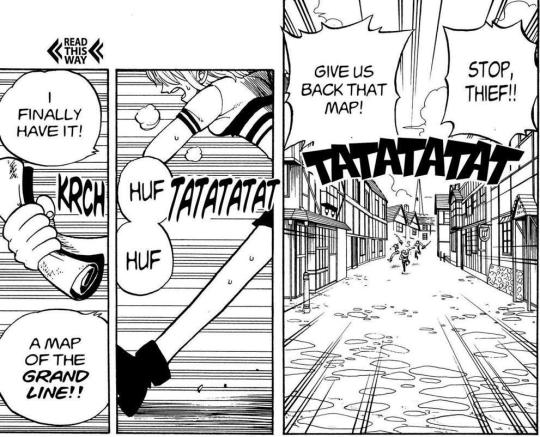
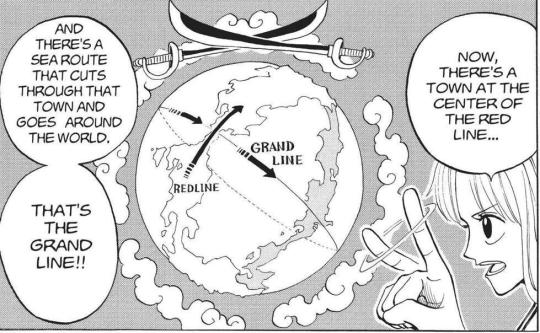
The settings and backgrounds of these early arcs tend to be sparse, minimal, and rustic: small houses, quiet taverns, little rickety boats, and tamed greenery. This, too, is a tradeoff. On the one hand, it effectively communicates how small this part of the world is, and on re-read this makes these early islands really stand out compared to the kinds of weird or grandiose places that the Straw Hat Pirates will visit later in the manga. It paints a picture of small communities and everyday people trying to eke out a stable existence on the periphery of the world, threatened by a mix of local crime and corrupt authority, which in turn point towards the existence of much larger forces.
On the other hand, those first forty chapters can feel a little drab because of this somewhat underwhelming aesthetic. Once the series starts to really hit its stride in the following saga, I think this is much less of a problem. And, just to defend the thing I just critiqued, @opbackgrounds has a cool write-up noting the differences between the architecture in the different villages, so although the settings aren't the most thrilling, their designs do still communicate distinct class and cultural differences, like Orange Town's obviously greater wealth communicated below, which corresponds to its success as a port town:

This same limitation of scope extends into the main conflicts. They skew small, with relatively minor pirate crews menacing the small towns that I described above. Unlike the antagonists of the "Paradise" [Ch. 101-597] and "New World" [Ch. 598-ongoing] portions of the story, who are admirals, warlords, emperors, and even a self-proclaimed god-king, the antagonists in these first three arcs are trying to acquire petty personal fiefdoms or fulfill private schemes, or in the case of that clown everyone was upset about a while back, reach *well* outside his grasp. It can feel a little "villain of the week," and in at least two out of four cases, with one edge case, that's an accurate label.
The two villains of Romance Dawn, for instance, are completely outclassed by our protagonists. "Iron Mace" Alvida and "Axe-Hand" Morgan never pose a serious threat to our heroes, they're largely vessels for Luffy and Zoro to display what they can do. They have two other useful qualities, though. First, they immediately set the tone for who the antagonists are generally going to be, a mix of Marines or government authorities, and other pirates with alternative worldviews to Luffy and the crew's. Second, they introduce some of the series' basic themes.
Both Morgan and Alvida rule by fear, with the former in particular demanding complete obedience, and using his rank in the Marines as proof of his own superiority and a means to personally enrich himself. By putting Luffy in conflict with these two, it suggests that the status of "Pirate King" maybe doesn't inherently carry the kind of connotation of superiority and command, or control over wealth, that you might assume. In the first chapter, we've seen Luffy glow with delight at the claim that "pirates have freedom." While the themes are a little embryonic at this point, it's clear from the start what direction the series is going.
In this way, most of the villains are direct foils for Luffy and the crew member being recruited in each arc. For example, Captain Kuro "of a Thousand Plans," the villain of the "Syrup Village" arc, is both a foil for Luffy and Usopp, willing to abandon his crew in pursuit of a quiet, shamed life as an ex-pirate rather than live loudly and proudly, and who relies on deception to advance his goals. Buggy the Clown, the villain of "Orange Town," has a boundless ambition for treasure that parallels both Luffy and Nami's aspirations, but while Luffy sees treasure in the variety of places and things that people value because of their history and connections to important people (like his own straw hat), and Nami's money-lust stems from a complicated history of hurt (which is only foreshadowed in this section), Buggy is simplistic and sadistic, incapable of seeing beyond himself.

A random aside: Buggy is an all-time gag antagonist, and unlike the other three, he will repeatedly resurface throughout the narrative. This is part of the core appeal of One Piece, imo. What seem like villains of the week or background characters often end up coming back, often in new roles. In Buggy's case, while he returns first as a minor villain and later an ally, above all he is essentially the series' longest-running gag: a man who is basically incompetent but keeps failing upwards largely through the misunderstandings of others.
This use of narrative foils to push specific ideas within each arc, which then form a web of interrelated themes throughout the whole saga or series, is a common feature of One Piece antagonists, but they get meatier and gain greater emotional complexity or thematic weight as the story goes on.
You might have noticed I've been quiet about the core cast so far, but now that I've touched on antagonists, it seems appropriate to say some words about them. But also, that's partly intentional because in the early days the information about our protagonists is relayed in a piecemeal way. We get basic backgrounds for Usopp, Luffy, and Zoro, but a better sense of who they are unfolds over time rather than in single chapters or arcs: how they behave with each other, the choices they make, what their personalities are like. This lack of instant information is deliberate on Oda's part. Luffy (after learning that Nami lost someone to pirates) expresses that he understands, but also indicates that he doesn't necessarily need to hear about it. These people aren't connected because they share intimate details of their histories with each other but because they have shared values and aspirations, and they inspire one another to pursue their goals.
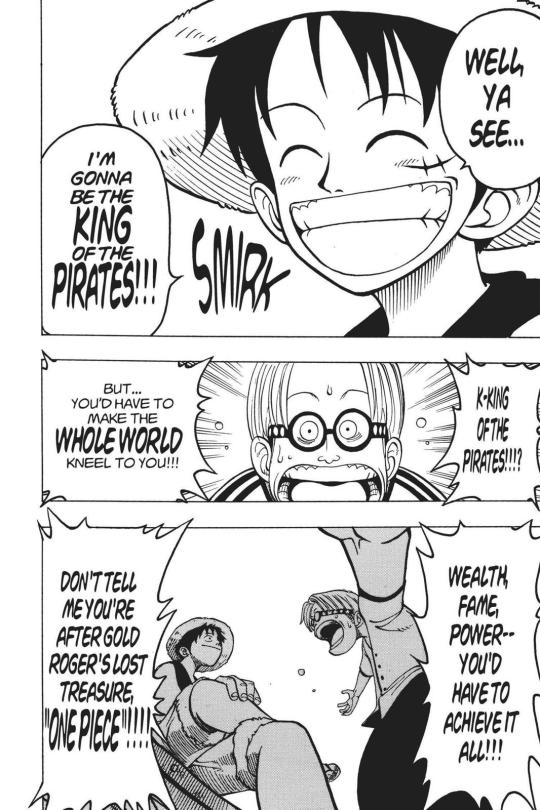
The way Luffy is written, for example, leaves open a lot of questions around his familial and early life until they suddenly come roaring back into the story way later. But we do learn a decent amount about him in this arc: he's a bit of a dope and not a great sailor, but he's a strong fighter, he has some sense of honor and bravery but isn't above being underhanded, and despite his lack of intellect he has a fair amount of tactical and emotional intelligence.
While he hasn't quite figured out to be the best possible leader yet, Luffy has a sort of natural charisma by virtue of his sheer unblinking willpower. His dreams and aspirations inspire others around him to pursue their own, seemingly unachievable goals. So far, so shonen. But where he stands out from other shonen heroes is that his goals are so defiant of how the world "should" work - a young kid who can't swim, with the silly power of "stretching," from a backwater village in the "weakest" sea in the One Piece world - that it naturally brings him into conflict with that world's social and political order. It'll be interesting to observe how Luffy develops as a character and a leader as the series continues.
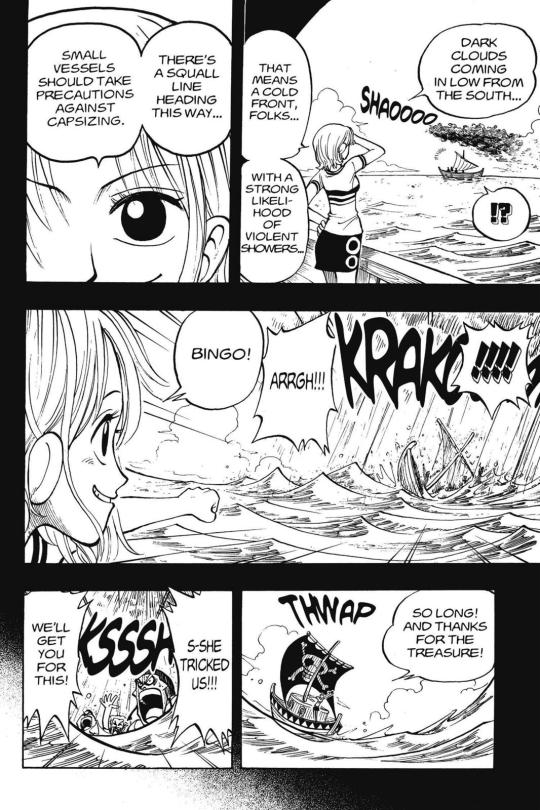
Each of the main cast is, fittingly for pirates, atypically heroic or arguably non-heroic. In spite of their position as protagonists, each one has an idiosyncratic personality, a self-interested goal, and a hoard of vices, and what's more is that these vices often aren't always positioned as things they need to overcome. Zoro is incredibly prideful to the point of putting himself in unnecessary danger, indulgent in alcohol, and easily gets lost. Nami is obsessed with making money and has an especially short fuse. Usopp is easily frightened and falls back on deception as a way to puff himself up.
And yet these are the things that endear the characters to each other, and us to them: Usopp uses lies not just to inflate his own ego but to make others feel better or to distract an enemy at critical moments; Zoro's prideful determination to basically defy all medical wisdom has saved the crew's life multiple times, as early as Orange Town; Nami's knack for stealing makes her a valuable asset under pressure, and her short fuse is because she often has to play the clever and rational member of the group.
I'm gonna decline to comment further on the remaining three characters, because I think while each of them gets time to shine in this section of the story, it'll be better to look at how they take shape in the context of the next string of arcs. Which means, once again, I find myself pointing to the long game as justification for what makes this section of the story work.
I think taken together, these qualities of the early series make it easy to see why One Piece is massively successful AND has something of a mixed reputation among non-readers, or people who pick up the first volume or two and then drop it.
My feelings on this earliest segment of One Piece are a bit mixed, myself. What makes it work for me is viewing it as part of an unfolding process, with the knowledge of what's to come and how the seemingly small and less exciting characters or concepts eventually swell in scope and emotional weight. But some of the emotional moments in this early section land with a bit of a thud for me (I've never been a huge fan of Zoro's backstory for instance), and the conflicts and characterization are hit or miss. But, considering the manga I've read that have stronger starting points but ultimately drown as they continue, there's a compelling case to be made that One Piece is a great example of manga-as-process rather than just a series of parts. It benefits from a long-term, serialized format in a way that not all works actually do.
Overall I'd say Romance Dawn is a little wobbly, while Orange Town and Syrup Village polish up the basic formula before it starts to get more complex in the next few arcs.
Next up, Baratie, Arlong Park, and Loguetown (ch. 42-100)!
30 notes
·
View notes
Text
The Cursed Holy Sword is far from the best written One Piece film but there’s a lot of elements in it that I would personally love to yoink and expand on. Zoro of all characters being placed in a conflict of loyalties is a fantastic pitch. Specially if it’s between Luffy and a childhood friend he promised to follow his dreams to who he thought dead for years. I almost wish they didn't just ignore how many parallels Saga had with Kuina and leaned into them, made him someone who also knew her and who could believably convince Zoro that she would want him to do the things Saga is asking him to, that he owes her this favor, or that the path he is following with Luffy could be a betrayal of the initial promise he made.
How would Zoro fare before that sort of manipulation, of having his strongest values held against him? How would he feel if told that the two most important people in his life (Kuina and Luffy) now stand in opposition? How would the crew help him navigate that conflict, if theyre able to at all?
How the movie pitched Zoro dealing with the aftermath of having his loyalties shaken like this was also interesting, with him rejoining the crew with this quiet shame about him. Which yeah, he should be ashamed here, since he fucking broke Sanji’s arm in the film, but still. I was surprised they didn’t really show him moving past it, or voicing his apology. Much to think about and rewrite methinks.
21 notes
·
View notes
Text
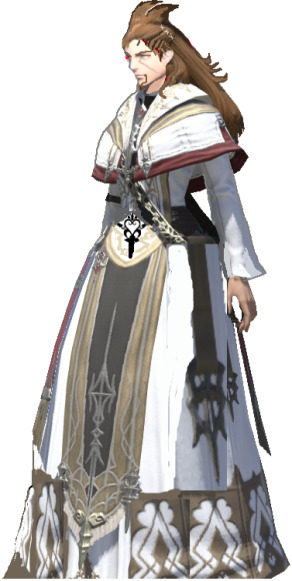
MASTER NARIX
"Every heart will return to the light, once all darkness is expunged!"
Time to ellaborate on this beautiful bastard! Master Narix is the overarching Big Bad of the third and final trilogy/"chronicle" in the whole KH Divergence Saga, the Hearts In Chaos Chronicle, debuting in KH4 after having been set up by the secret epilogue of KH3, then serving as the chief antagonist in The Missing Links and one of the main antagonists/final bosses in KH5. The founder and leader of the Luminous Vanguard who dissolved the Dandelion Guild and its unions ages ago, Narix and five of his followers chose to enter a state of time stasis once it became clear to them how impossible the task of eliminating all the darkness and Darklings brought into the World by Darxomnious was, so they'd await the day when Luxu fulfilled his mission and the World was cleansed of that evil, at which point the Vanguard would return to construct a new World order.
Narix has long believed that the majority of hearts are naturally weak and susceptible to darkness that begets dark powers that defile the World, and that only the strongest and purest of hearts should set the course for the World and its denizens. Envisioning a reality where darkness no longer exists, light conquers all Worlds, and he reigns supreme as the light’s oppressive guardian, Narix arrogantly looks to use blight to tear down and reconstruct Kingdom Hearts from within its innermost heart, and will eradicate all that would get in his way.
Since the character concept of Master Narix only solidified fairly recently, most of what I can say about him here are some tidbits:
Quite obviously, I designed Narix as a Contrasting Sequel Antagonist to Xehanort by nature. Xehanort was a former Keyblade Master turned darkness supremacist, Narix is a non-Keyblade wielding Master who's become a light supremacist. The quote up there is even a direct parallel/reversal of Xehanort's famous line "Every light must fade, every heart return to DARKNESS!" And it really ought to be stressed how equally dangerous a light supremacist out to erradicate darkness from the World would be, as not only is, in a wise king's truthful words "the World made up of light and darkness, you can't have one without the other 'cause darkness is half of everything" so the removal of darkness would bring only imbalance and instability, but as has been established before, approaching the task of fighting darkness in a violent, hate-filled, stubborn and self-obsessed way only further feeds the darkness and begets more of it, which Narix is actually smart enough to know since he exploits that with the "blight" power and think it a worthy means so long as the ends he aims for can justify them. He's like Master Eraqus’ moral absolutism and ideals of light supremacy taken to the furthest extremes possible.
"Now wait a minute!" I hear some of you asking "You said back in this post about the Star Wars sequel trilogy "Apparently a whole lot of folks just think having this one guy serve as the overarching main antagonist, direct or indirect, for two trilogies and then having a completely different guy from right out of nowhere with no link or connection to the previous guy nor anything from the last six installments step up as the main antagonist for the third and final trilogy is perfectly fine storytelling so long as the second guy comes off sufficiently Big and Bad enough or whatever.", but how is what you're pushing with Narix any different?"
There are three major differences. 1. Yes, KH Divergence reimagines the whole Kingdom Hearts saga for 25 years as a trilogy of trilogies, and yes all of those trilogies are intertwined to connect with each other in some way, but they are not CONNECTED in the same way Nomura likes to do; while they share the same universe, cosmology, history, themes, and basic common elements across them all, each chronicle is still more or less its own complete story than can stand on its own even if you did not experience the other ones, with even the handling of continuity being kept as newcomer-friendly as possible in the way most game series' are. 2. Narix keeps with the running theme of "darkness begets more darkness". Darkness in the hearts of people begat Darxomnious, who begat darkness in Luxu, whose actions led to circumstances that begat darkness in Narix, whose actions led to circumstances that begat darkness in Xehanort, whose actions begat darkness in Vanitss and Maleficent and Braig and Ansem the Wise and many other villains, essentially putting the whole series as it began in motion, and so in the series' present day narrative the arc with Xehanort begets the arc with Darxomnious which begets the arc with Narix. It's cyclical by design. And 3. Xehanort still factors into the last trilogy as the one who created Evanessé. When you get down to it, Xehanort was THE chief antagonist of the first trilogy - the KH Trinity, or the Door To Light Chronicle - and of KH0.1 (BBS) but was just part of the Big Bad Ensemble in the second trilogy (playing second banana to Maleficent and Darxomnious in the second and third games of it), and a posthumous Greater Scope Villain behind one of the antagonists in the final trilogy. So you can't say he ever stopped mattering here.
Narix's name is derived from a double meaning. Like the other Lost Masters names, it's a play on one of the seven deadly sins (Avali = avarice/Greed, Fura = fury/Wrath, Gorgeyo = gorge/Gluttony, Jelus = jealousy/Envy, Ecaed = acedia/Sloth, Luxu = Lust); as Narix's sin is Pride, his name refers to Narcissism. The NAR in his name, with how it's pronounced like that, is also pulled from the word "Lunar", as in the moon, like Kingdom Hearts itself. Additionally, it felt right to put the "X" letter at the end of his name. Xehanort had it as his name's first letter (as did Xemnas), both Darxomnious and Luxu had it somewhere in the center of their names, Narix has it at the very end.
His hair being brown is also a deliberate choice. Sora was a brunette hero whose nemesis was silver haired. Now we have Ephemer as a silver haired hero whose nemesis is brunette. It's poetry, it rhymes! And the weird styling of it where it goes up into double pointed ends is meant to call to mind rabbit ears. Yes, rabbit ears. It's another reference to the whole "lunar" connection: the fabled Moon Rabbit.
Design-wise, Narix is meant to invoke vintage Final Fantasy villains, primarily the evil Emperor Mateus from Final Fantasy II. This would also work coming off of Xehanort, who was either a straight-up Disney Villain (Master Xehanort in KH0.1/BBS), a Disneyfied Final Fantasy Villain (Terra-Xehanort/Ansem), the Disneyfied Final Fantasy Villain so re-Final Fantasified that he becomes fittingly an in-between "neither Disney nor FF villain" KH Villain (Xemnas), or a crappy Shonen villain from a crappy Shonen manga/anime (Master Xehanort in every game since BBS in Nomura's KH Canon).
Speaking of, Narix's motivation should ring familiar. He wants to clean the universal slate so that darkness is no more, the World is pure and bright with the light of Kingdom Hearts always shining over it, and he remains bound to Kingdom Hearts' inner heart in order to forever safeguard that light and reign over all who have hearts in an oppressive way, "to stop the weak from polluting the World with their endless darkness - to dictate their destinies." Yeah, THIS is the sort of antagonist such self-righteous and fascistic motives actually works with as opposed to shoehorning them onto an established immoral researcher who has historically fancied the darkness. Xehanort started out believing he could "tear down a tyranny of light". Narix wishes to instill a tyranny of light. And the way he seeks to do so is truly insane: he wishes to dismantle and reassemble Kingdom Hearts itself from within its inner heart (to clarify, Kingdom Hearts' "outer heart" is what birthed the World. It's "inner heart" is what birthed every other World and keeps it tied to this KH multiverse) so as to eliminate all darkness across the multiverse, all costs be damned. In doing so he ironically creates an evil force called “blight”, light that’s been perverted to the point where it works in tandem with darkness.
Whatever else can be said about him, Narix is definitely a man of strong ideals and convictions. And one prominent ideal of his is his absolute abhoring of Keyblades. The events of Waning Way, learning more about the Keyblade War, and what occured with Luxu all served to make him swear off the weapon, believing such a weapon to not be fit for human hands. He passed this belief down to his followers in the Vanguard as they cracked down on Keyblade Mastery. The reason the Guardian Keybladers in KH0.1 is such a small and secretive order? Yeah, this would be the reason.
(And seeing how out of hand Keyblades got it Nomura's canon, I can honestly kind of sympathize!)

Now, don't confuse Narix for a Frollo or Emperor Belos type of evil, bigoted, hypocritical religious fudamentalist villain who have openly unpleasant personalities that we can all recognize as being evil beneath the superficial charisma - Narix is a very convincingly affable, charming, parental and seemingly noble individual, which makes it all the scarier to see his more pompous, self-obsessed, and even cruel side come out, especially the more he dabbles in blight and darkens his heart and soul. Narix can also be quite humorous and snarky, not in "lol weird and random" way like the Master of Masters, nor even like Xigbar, but in a more "Ardyn Izunia" way.
For Narix's English voice, I had to think of a VA, namely one who's a big name in anime and video games, who was a super veteran in the industry for years now and would be officially middle-aged by the end of the 2010s yet has a voice that retains this youthful quality to it, capable of performing the smoothy, silky, mellifluous voiceover that the character would need. Who could that be none other than the one and only Johnny Yong Bosch. A sampling of how he'd sound:
The nature of Narix's main power, "blight", is quite insidious: the Masters and lower mages of the Vanguard use their staves to steal light from other people's hearts and transfer it into the veins of creatures of darkness, creating this power where the darkness and light intermingling with each other causes one another to go totally out of whack. It effects the new "Demi-Deterged" Heartless so that rather than be attracted to the darkness of people’s hearts with the instict to prey upon those hearts, they seek out darkness and attack it in violent ways that prove dangerous to the hearts they come into contact with and destructive to the very fabric of the World itself.
While the full stories and scenarios for the Hearts In Chaos Chronicle entires are incredibly hazy to me overall right now, one of the things I can see very vividly is the Final Boss stage for KH5. Basically, the final world brings us back to...well, The Final World, right to Kingdom Hearts' doorstep, at which point a fucking enlarged, Demi-Deterged Chernabog starts tearing up the place and becomes the Climax Boss. And then comes the Final Boss, which is, I shit you not, essentially the one famous Kamina line from Gurren Lagann - "the Drill that will pierce the heavens!" An enormous tower-like contraption that is trying to drill its way into Kingdom Hearts to reach the inner heart, and three competing factions for light, darkness, and nothingness are all trying to make it work in their favor. Stage 1 of the fight pits Ephemer and friends against all the strongest "miniboss" tier enemies in the game all at once. Once that's cleared, Stage 2 is against Neodarkness and his powers of darkness. Clearing that gets you to Stage 3 against Evanessé and his powers of Nil. Clearing this advances you to the penultimate stage where of course it's Narix who's the last one standing. The final phase is triggered when the blight at last becomes too much for the unhinged Narix, filling his heart with darkness, becoming darkness itself! Defeating Dark Narix finally brings the whole thing down, freeing Kingdom Hearts and keeping the multiverse still in order. A completely broken Narix still insists on the rightness of his cause and how he could've improved all Worlds, at which point Maleficent enters the scene to zap him with her newly restored dark magic, obliterating his heart and physically transforming him into a basic Darkling who fades to the Dark Realm.
.....Hold on, I feel like I might've heard this story from Disney before.

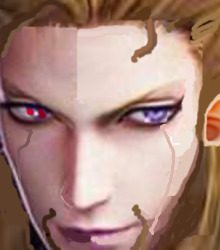
A character model for Master Narix, and a close-up of his face.
#Disney#Kingdom Hearts#KH Divergence#disney villains#Master Narix#KHIV#the Missing Links#KHV#oc#headcanon#trivia#analysis
11 notes
·
View notes
Text
I know a lot of people compare Houses to the Shin Megami Tensei franchise, specifically the Persona series because of the school setting. I'd add that the game making allusions to various real world religions through it's symbolism, as well as using the tarot, would further this. Not to mention, how some games give the story as breadcrumbs and expect the player to figure everything out from those. However, I don't feel that Houses is meant to invoke the Law/Chaos/Neutral alignments with it's routes because Law and Chaos are meant to be two sides of the same coin, invoking what Michael Moorcock intended when he created in his works before Dungeons and Dragons bastardized the concept, whereas neutral routes tend to go against the idea of coexistence to the point of being criticized as genocide routes.
But as I thought about this, I couldn't help but feel something. Edelgard embodies the WORST qualities of the three alignments.
With Law, Edelgard seeks to impose her will upon the people of Fodlan and is willing to go to horrific lengths under an “ends justify the means” mindset. The game accuses her of wanting to replace Sothis with herself, even to the point where she takes over the Church to spread her own messages. She'll talk about how she will protect those who support her but destroy those who oppose her or her ideals. Siding with Edelgard an act of blind faith, as from the beginning of the game we've seen evidence of her evil deeds. It also means ignoring Byleth's character and changing the story, us pushing our choices onto Byleth, who would otherwise side against Edelgard of their own free will.
But then you look at Chaos, which promises freedom. Except it's a social Darwinist form of freedom, where the strong oppress the weak. Chaos tends to try and make people join it of their own free will, but is not above manipulating you as well such as in Nocturne where Lucifer's manipulations will strip the Demi-fiend of his free will in the True Demon path. And despite all the talk about YHVH being a tyrant, Lucifer is the strongest demon of the Tyrant class linking to the fact that for all her talk of freedom, Edelgard's path is supposed to lead to tyranny and oppression as she imposes her social Darwinist beliefs on Fodlan. The fact that Edelgard invokes demonic imagery, specifically Baphomet, only serves as the icing on top.
At the end of the day, however, the two aren't that far apart from each other. Hell, angels will support social Darwinism in Nocturne because it provides them a means to look down upon others. This owes to Moorcock, where either side achieving absolute victory would spell the end of the world.
Then you have the Neutral routes, where you reject heaven and hell to create a path for humanity. We could see this as Edelgard taking out the Church before removing the Agarthans. But this means wiping out those who've helped you, meaning that humans can only achieve freedom from gods and demons through the help... of gods and demons who've they made to support them. It, and the implications of genocide against non-humans, make it more human supremacist than anything. But in other instances, it's framed as putting things back to the way they used to be which is what Edelgard says she's doing in the Japanese version. This is in contrast to Fire Emblem's themes of coexistence.
Edelgard embodies the worst of each alignment, and you can't help but feel it's meant to be a criticism of the system in the first place. Such an alignment system doesn't really work, as it narrows everything down to some extreme. It leads to either ideological or religious zealotry where every choice sucks various degrees of ass. It's hard to say that a SMT game has any real morality to them, aside from spin-offs like Persona or Digital Devil Saga, as not matter the route you perform questionable actions (play SMT2 as a traditional good guy to see what I mean). Despite this, player characters have been referred to as “messiahs,” even TDE Demi-fiend.
And I think that's the true message of Houses. It's against zealotry, blind faith and how that's used to justify atrocities. I'm going to point out a few things before continuing.
Edelgard's nickname is “El,” which is an ancient word or title referring to a god. At the end of Flower, the player is made to call her that if they choose her S support.
Building off of this, the devs said that part of the theme of Flower was having different beliefs and because of those beliefs mowing down anyone who stands in your way.
Conversely they identify Byleth's flag, the save icon of Silver Snow, as the game's Fire Emblem stating it reflects the belief others place in Byleth.
Byleth gains the powers of the Goddess Sothis, while Edelgard is accused of wanting to replace the Goddess with herself as she reshapes Fodlan to suit her ideals.
Ergo, Flower is about the player believing in Edelgard over Byleth (as Byleth's default choice is to fight against her), her taking over the role of the game's god figure. But to do this requires the player to ignore what they they don't wish to see, much like Edelgard herself does. It ignores what she was working with the people you fought all through-out White Clouds, providing them aid in addition to hiring an assassin with orders to kill her classmates. In addition, it involves looking the other way when Edelgard's claims are contradicted by the worldbuilding, when acts as a hypocrite, when innocents are hurt or killed as part of her plan or even the implications of endings unique to her route. Most of all, it means ignoring the growing pile of evidence that Edelgard is a liar who will say whatever she needs to in order to look like the hero.
In other words it takes blind faith in Edelgard, or wilful ignorance, in order to complete Flower. But then compare this to Rhea, Dimitri and Claude. How Rhea's belief in her mother caused her to ignore Fodlan's moral decline as she believed that when she revived her mother, Sothis would fix everything. Rhea, if she lives, gets her best ending when she realizes this failing and instead returns to , duties as Archbishop and the results are said to be miraculous. Dimitri's beliefs led him to killing those who hurt others, believing his duties were to the dead even if it meant he became a monster himself. He's saved by realizing his beliefs were wrong and his real duty is towards helping the living. Meanwhile, Claude's own ideals are hypocritical on his part until he puts aside his prejudice against the Church. Kinda hard to champion accepting the beliefs of others when you decide to destroy a religion you blame for Fodlan's problems, especially since Claude realizes just how wrong he was about the Church in his initial assessment.
You could make an argument that Rhea, Dimitri and Claude all start off as some form of zealot and their best development is to grow beyond that. Byleth's story is about seeing what Edelgard does and not turning a blind eye, seeing Edelgard's actions for what they really are, and doing the right thing regardless of how it makes them feel.
The various types of symbolism then become an extension of this. They symbols all point towards the same truth, regardless of their background. If anything, they're meant to show how universal this lesson is. That if you hold your beliefs to such a level that you're willing to reject reality (or in the case of some players, the game's script and authorial intent) for them, then those beliefs are a problem. The fact that Edelgard, when pressed, blames the people if her ideals don't make their lives better is meant to show how disconnected from reality she actually is, and with her demonic Hegemon form being presented as the personification of those ideals while Dimitri ends up with the messianic title of savior king, it doesn't take a genius to figure out whose side the game is actually on.
If Edelgard was meant to be a good guy, her fans wouldn't be telling others not to listen to the game's creators. Nor would they be telling people to read a fanfic to understand the characters, or trying to dismiss everything else the game says. Flower is a villain route, and that's okay. It is what it is, even with the translation issues messing it up somewhat. It doesn't want you to ignore the truth about Edelgard, it want you to see the truth.
9 notes
·
View notes
Note
why do you hate the netflix show? i'm genuinely curious, as my wife adores it and was also a huge fan of the animated series growing up.
I mean the TL:DR of it is I just think it's a bad show. I found the pacing strange, I didn't like half the characters so it was hard to root for them, Season 1's plot was so awkwardly paced it was boring, but in Season 2 there were like 3 different plot points per episode and I found them hard to get invested in. The LONG answer: my 3 biggest problems with the show were (!):
The blatant racism/whitewashing
This is pretty self-explanatory and I've gone over it before , so I'll keep it brief; the show's whitewashing was the biggest turnoff for me. Musa and the fake out Flora (because Eliot Sal WAS originally Flora, hope whoever made that change got a bonus) were awful, and then the treatment of Dane and Aisha's characters sucked (being taken advantage of by Riven and turning into a huge asshole, and Aisha being turned into Bloom's life coach). We got a little more diversity in Season 2, but by then it read more as a response to backlash than anything else. Same with Dane and Aisha; Aisha gives a little speech in Season 2's first episode where she says she's done being Bloom's life coach, and then proceeds to get a boyfriend who's secretly evil and lies to her all season. And Dane acts like an asshole for 2 scenes before he's shoved to the side as a supporting character.
2. Homophobia
Again, recap from my last rant; Season 1 was very straight. The Bloom/Sky/Stella love triangle took center stage, the only non-straight character was Dane, who I'm 90% sure was bisexual but we'll never know because not once in Fate: The Winx Saga does anyone say the word 'bisexual.' The closest we get is Dane saying he finds both Riven and Stormy Beatrix hot. But Dane, Riven, and Beatrix turn into this awful polyamory thing that goes on for like an episode and a half before it breaks up, and it's never spoken of again. Season 2 gives up an openly lesbian character, Terra, but her love interest (a female specialist whose name I don't remember) is in her own on-again-off-again relationship. Terra and the girl do get together, but last the audience knew the relationship was on! So Terra gets a girlfriend, but said girlfriend is a cheater. Gay rights? oh, and #JusticeforFrancesa
Those are the serious reasons, and with those out of the way I would argue the other really big reason I didn't like Fate was
3. THERE IS NO FRIENDSHIP
At the end of the day you can take away magic, the Specialists, and a lot of supporting characters from the show because the core of it - the reason Winx Club works so well - is because these six girls are best friends. The show is about them going through school and breakups and universe-saving together, and kicking ass at it because they have each others back. It is the show's central theme, it's where the best writing is, and where some of its best moments come from (for me at least).
Fate...does not do that. They started the series out making Sky the one to show Bloom around Alfea and introduce her to things instead of Stella, sidelining one of the strongest friendships in the series for the sake of a love triangle. And it only goes downhill from there! I get the whole 'take an episode or two to figure out where we stand as friends' but by the end of the 1st season these bitches are still fighting over the dumbest shit! We start out Season 2 with Stella using invisibility spells again so she's not seen with the other girls - I don't even think Stella likes any of them by the end of the series! Sure everyone goes to classes and plans dangerous missions to save the world together, but outside of that it doesn't seem like they even like each other. There are moments sprinkled throughout where they're supposed to be genuine friends, and they're easily some of fate's best stuff (the car scene in 2x01 is an example). But they're also awkward, because 20 minutes ago they were sulking in their rooms and yelling at each other about their lack of communication. They aren't deserved is the point I'm trying to get at here, and the only way they do feel deserved is if you a) already know their friendship dynamic because you watched the animated series, or b) you follow the actors on social media, where they actually talk and hang out like best friends.
The strongest friendship in this entire series isn't any of the girls - it's fucking Sky and Riven. Because they were pre-established best friends, had arguments throughout season 1, but by the end of season 2 had come back together because the world was in danger, and they both knew despite everything, that they would have each other's backs. Do you know how badly you have to fuck up, where one half of your best friendship is the queerphobic, predatory asshole character, and the other half is a slice of untoasted Wonder Bread?
Do you know how mad Riven would have been if Sky went to not-Omega with Bloom in the season 2 finale? He would have been fucking pissed and ordering everyone to a classroom to give his 30-slide power point on how to get them back within 3 days. Meanwhile Bloom doesn't actually say goodbye to the Winx girls, she just writes them letters and says goodbye to Sky in person (because it is well established that Bloom and Sky's romance is more important than the girl's friendship, let's be honest). And then girls are all hugging and Stella's crying that Bloom's gone and I just thought 'you spent more time with Beatrix than Bloom this season Stella, why the fuck are you sad.'
This is all a longwinded way to say the central theme of friendship was pushed aside for CW-style romance, which made the core cast of girls unable to connect, which made the show bad.
Fate had the same overall runtime as a single season of Winx Club. Later seasons are bad, don't get me wrong, but those original 2004-2007 seasons had twice the character moments, more concise plots, and felt way more fun than anything I saw Brian Young put out these last few years. I would watch an original season (and even season 4! sue me!) any day over Fate the W inx Saga.
Thank you for coming to my Ted Talk, and probably don't show your wife this.
#anti fate the winx saga#netwinx#liz suffers with netwinx#liz gets questions#anonymous#im sure this was a way longer answer than you expected nonnie#my bad#ive just had a lot of pent up feelings on this show#long post
98 notes
·
View notes
Text

One Piece Card Game Booster Pack 0P-05
AWAKENING OF THE NEW ERA
releases world wide on
December 8, 2023!
Don’t forget to check if you want to pre-order this from your local card shop, and look out for pre-release events starting Fri. December 1!
This Set focuses on characters from the Sky Islands Saga and the Revolutionary Army!
Under the cut are the Points from the official website!

To commemorate the 1st Anniversary of the ONE PIECE CARD GAME this release includes a card that features an original illustration by Eiichiro Oda!
Get this ultimate card we are presenting to all ONE PIECE fans here!!



The all-powerful God Enel and Sabo, Ranked No.2 in the Revolutionary Army, are two of the many characters from Skypia and the Revolutionary Army making their debut in the game with this release!

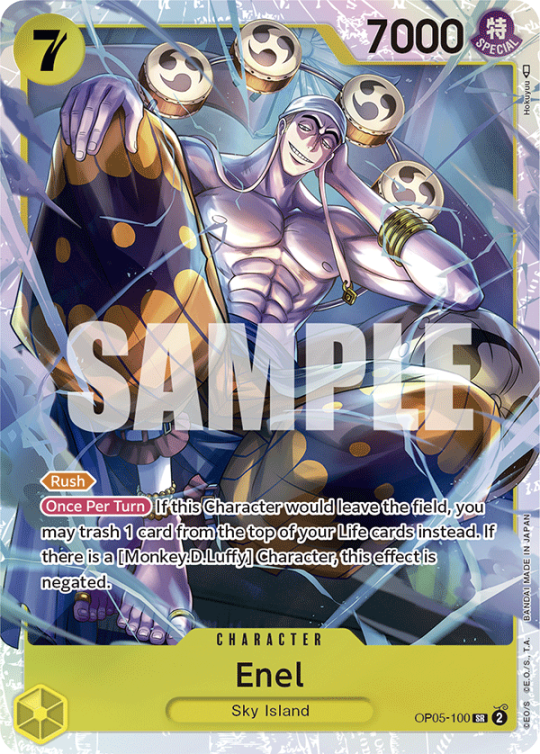

At last, the strongest stage, "GEAR5" is reached! GEAR5 Luffy makes its debut in this Booster lineup. Even Kaido who fought fiercely in Land of Wano arc is also in the lineup!



Manga illustration leader cards from "ROMANCE DAWN" and "PARAMOUNT WAR" are getting parallel versions and will be included in the lineup for "AWAKENING OF THE NEW ERA"



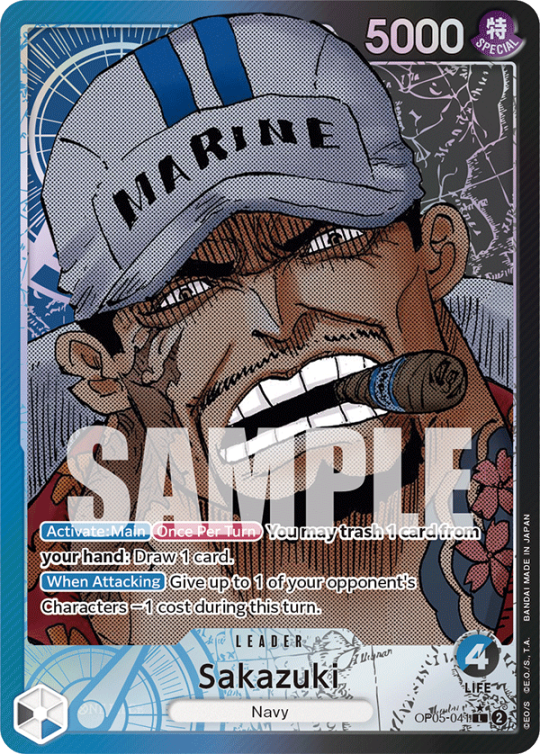

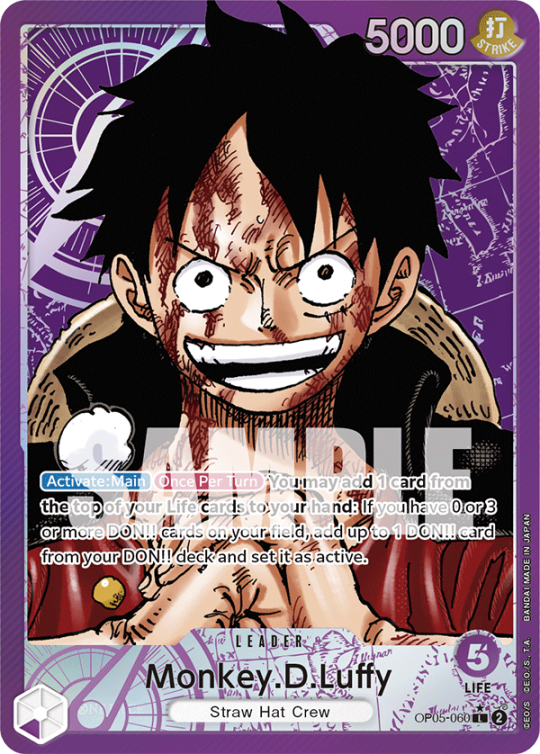

Be sure to get these luxuriously designed cards!




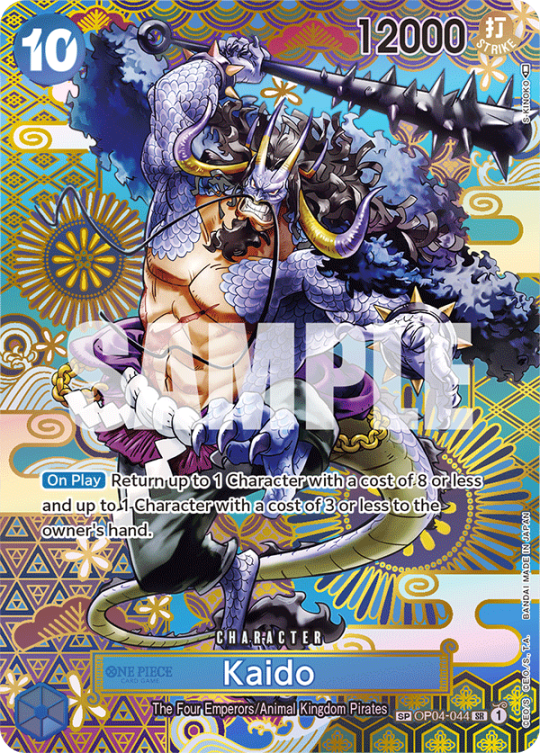
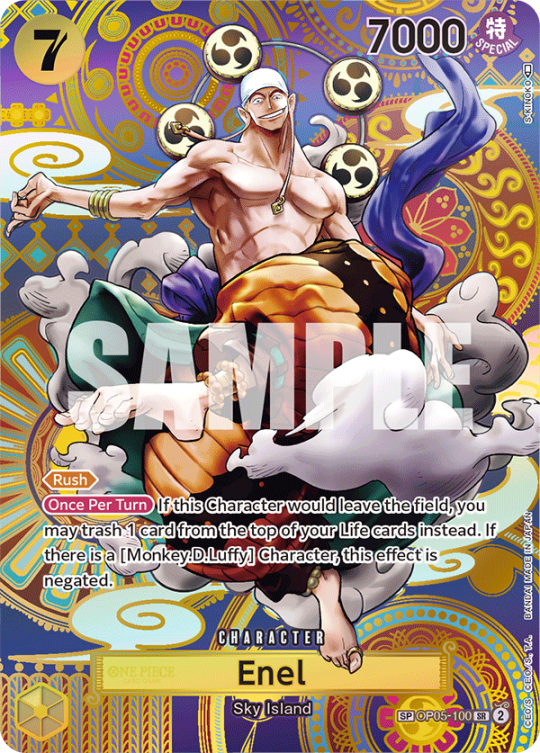

Previous booster pack only included 1 type of Super Parallel cards but, this time there are 3 types in the lineup! Be sure to get the Super Parallel cards of the 3 captains!
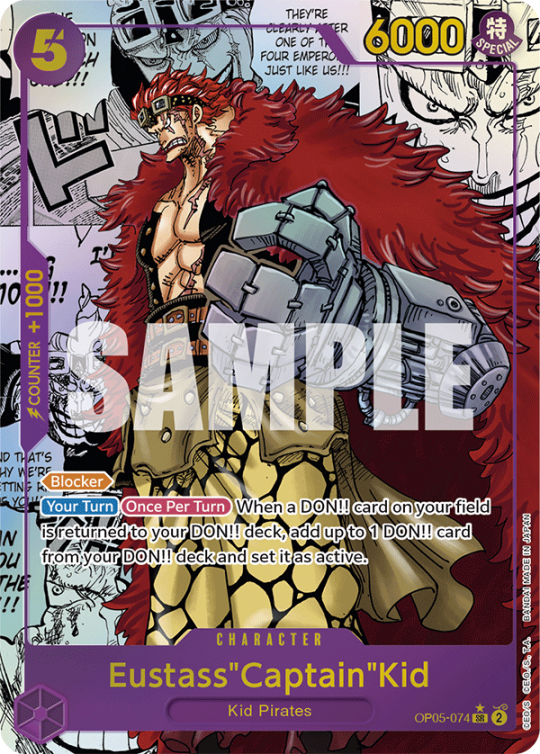

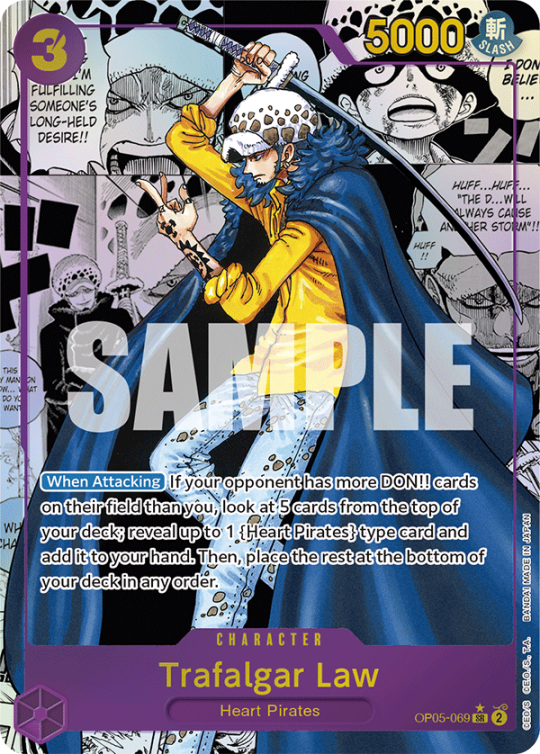
10 notes
·
View notes
Text
Arguably one of the strongest character building episodes in the entire series, The Daisho Caper is fantastically unique in its motivations, gorgeous scenery and animation, and subversion of expectations. I’m so ready for this unique and spectacular episode. LET’S GET IT GOING!!!!
(and yes. im mega late. working on it. notes under the cut as always!)

I love this infodump section so much. It’s really beautiful and super unique in that it starts the episode and also happens in a flashback (almost everything about this episode is unique?? From singing to a rejected redemption arc there are lots of things in this episode that never happen again
LIL BABY CARMEN
AWWW WAIT CARMEN ASKS IF HE CAN TAKE HER TO JAPAN AND YEARS LATER HE GETS TO. DAD MOMENT
And you can see how shadow-san distances himself from her as she gets older
Sleepy carmen <333
Sleepy EVERYONE
SHADOWLOLADLOWLEHEE HOO
That ironic little “heh” carmen does is so. Yeah i dont know i love it
Man hideo got SUMMONED she put one finger on the glass and he teleported
HOW ABOUT SORRY, CARMEN
Hideo is honestly so perceptive he would kill it in miraculous ladybug /j okay but seriously he’s already noticed what she knows and he even recognizes her when. Literally not even the law enforcement agency dedicated to catching her could at one point
“Dark forces” checks out, seeing as shadow-san basically means mr. shadow
I love when they get bitchy with each other
Also HI the animation is SOO PRETTY THIS EPISODE
More than a feeling by boston. Its by boston you guys do you get it its by boston
Also this karaoke scene SLAPS
Not zack pulling down shadowsan’s clothing. Yas bitch show a little slutty shoulder
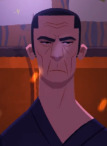
THEYRE HAVING SO MUCH FUN <333
Zack and ivy: thank you thank you!!!!
Carmen and Shadowsan: okay well now that theyve shut the fuck up we can continue talking i guess
MAN HE SAID SPIES AND ASSASSINS AND HE’S REMEMBERING DEXTER…SPYING AND ASSASSINATION WAS WHAT HE WAS THERE FOR AND HE HAS TO CONFRONT IT NOW
HE CAN’T REALLY BECOME A SAMURAI IN THE EYES OF HIMSELF AND HIS BROTHER UNTIL HE CONFRONTS THAT PIECE OF HIS PAST AND LEARNS TO GROW FROM IT WITH CARMEN. MAN THIS EPISODE
PAPER STAR <333
Wait dokuso says “i called you here” do senior operatives have some caper perms? Can dokuso contact the faculty and be like HEY can i borrow paper star
Not quite sure what the little maneuver in the air was supposed to help avoid because it did. Nothing
HNNG okay i’ve dumped on jo’s DMs about this shot but its SO pretty
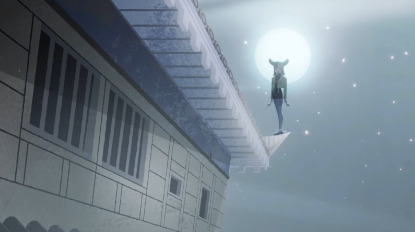
Follows the rule of thirds line, the gorgeous lighting, paper star framed in the moon, the perspective and use of space, the petals blowing in the wind, glowing in the light. ACTUAL LITERAL ART
Rip deleted scene where paper star says “sheep dont fly” the first time ig
Season two and those slide-under-projectile shots
Carmen and chucking painful building materials at evil gay women this season
Carmen loves that little flip over the shoulder move
Also I LOVE that you can just watch Carmen figure out who Suhara is immediately its cool

whats up with the dirt on his face
SO BEGINS THE VILE FACULTY SAGA honestly such a fun plot point from this season they'll literally try out anyone
GOD the bridge and the cherry blossoms and the water have I mentioned how gorgeous this episode is
there's always more to the story with shadowsan
also mmm i love. i love that carmen isnt quite certain, so she says "suhara" very quietly. she's testing it out, and the look on shadowsan's face is all she needs to figure out that she's right
just another little tiny clue that shadowsan knows more than he lets on about her past. why would he be guilty about simply not knowing where she came from? if his cover story was true, he would if anything be carmen's savior from a terrible death or being picked up by some random people or something. just. god really good.
SHADOWSAN IS SO TALL NEXT TO HER SJDGDHS
god that transition with the cherry blossoms was good
i feel so bad for hideo he didn't deserve shadowsangst
btw i want to see a spinoff with the faculty/shadow-san's school and early crime days
man the confrontation scene is so raw. hideo is shaking, holding that sword, but he is fucking ready to fight his brother about keeping the sword. man its good
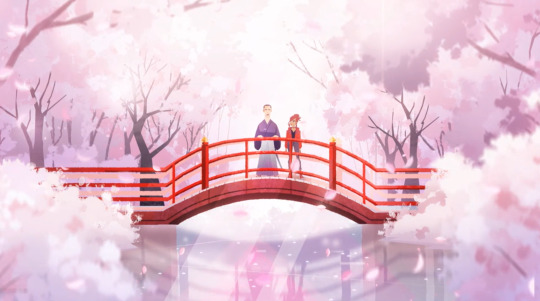
appreciate the scenery
that reveal of the shot being a puddle is also so good this episode is literally art
i love rewatching this episode for the little details- the camera always stopping before ivy's face, the swords discreetly disappearing as the cart goes by. you don't even notice the first time
i know they kill people and stuff but the hoodlums are kinda sweet. yess kings sing that karaoke
i wonder if the elvis song was a nod to the elvis episode they wanted to do with shadowsan (duane said they had to scrap it and im SOOO MAD)
ivy and zack must just have full charisma stats bc i dont know how they keep getting away with blending in literally everywhere. maam thats a white bitch in a wig
i love the three of them immediately sweating their balls off when shadowsan grabs the sword
EVEN THE IMPACT FRAMES ARE COOL

btw the tattoos in this episode are cool i wish more non yakuza members had them
that app on carmen's phone is a gaydar
how long was paper star just sitting in the packaging just going "ooghhh yeah im like a fucking jack in the box im gonna scare her so bad ooogh"
i love the kitty fans
not sure what carmen was going to do with the fans anyway seeing as she doesnt know how to use them as a weapons but whatever
oh nevermind she. i guess does
i love howw carmen just like. rides paper star
girlie has to stop strapping shit to her back it does not work

another one of my favorite shots in the show the lighting is sooo beautiful
i also like how carmen is looking down, not trying to shake her off, reaching a hand down- she doesn't want paper star to fall to her death, obviously
i was like damn how did that little fall knock both of them out cold but paper star LANDED ON HER NECK

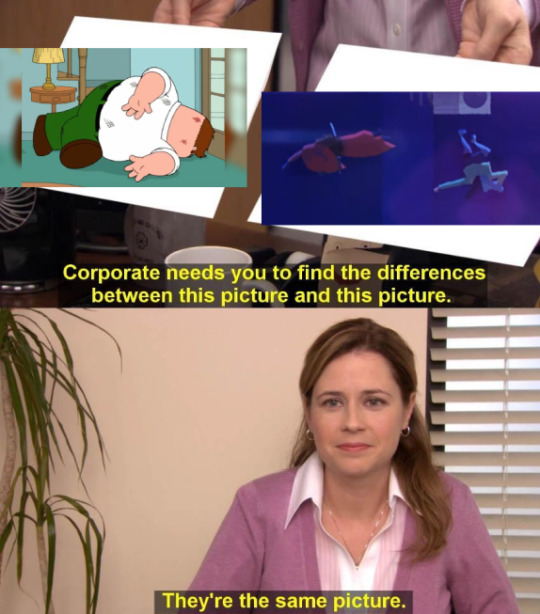
PARTIES OVER ELVIS IS GONE
i love the very minimal music when dokuso and shadowsan are fighting its cool
get poisoned
i think they reused the shadowsan poisoned groaning sound twice in a row
anyway also a nice shot here

it seriously looks like paper star was just lying there and as soon as she heard carmen get up she was like oh chill nap time is over
that climbing the ladder animation was so slick
so wait. they predicted? that paper star would not only be hidden in the sword room but latch onto carmen's ankle and follow her all the way up to that roof. so they could glue her
kill kill kill
the anime glasses on dokuso are awesome
out of context it looks like carmen just murdered shadowsan in a swordfight
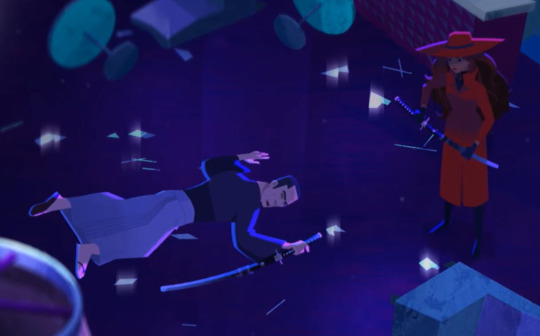
god the empty room. and then you pan down and shadowsan is kneeling. good shit
MAN what a fantastic scene. he does exactly what shadowsan asks him to- does not forgive him, because he does not yet see a reason to. but he allows him to correct that mistake. what . god what a good rejection of a redemption shadowsan HASN'T redeemed himself (fully) yet it just makes sense
mmm when he appears from behind her and her spidey senses go off. its good shit
just that emotion on her face. she's sympathetic that his brother didn't accept him back, but happy that he'll still go with them on their journey.
now, this is the only time we get a voiceover from carmen (other than when she's talking to crackle in the pilot) and its such a stark choice. like the only time we ever really get an inner monologue from carmen that lets us know how she feels about it
everything about this episode is just so fantastic and different! cs thrives when it dives into character motivations...but it just doesn't do that very much. there are so many unique choices in the episode- from the untraditional infodump scene to the music to the gorgeous animation/lighting to the voiceover to the rejected redemption scene to the hints at shadowsan's true past with carmen...i could keep going on and on about it forever, but I won't. you've seen the episode. its just. argh. its so good
okay that's all from me. hopefully I can get the rest of my cs weeklies out sooner rather than later- im almost done with finals!!
27 notes
·
View notes
Text
Bread's Game Of The Year 2023, #5: Cyberpunk: Phantom Liberty
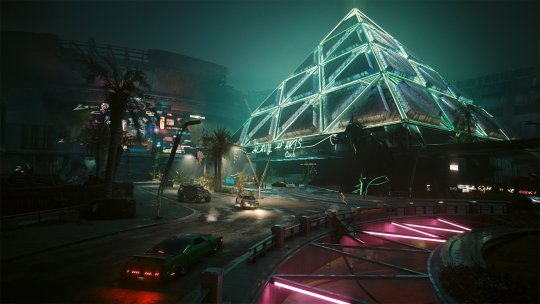
2023 is one of, if not the, strongest years ever for video games as a medium of entertainment. I am limiting myself to five entries for my longer form GOTY list, because describing all ten of what I consider to be the best games of this year and why they resonate with me would be a herculean task that frankly, I don't know I have the mental capacity for anymore. I can do five though, and coming in just under the wire, isn't quite a full game, but welcome to my first instance of bending the rules in this series of posts: Cyberpunk Phantom Liberty.
I don't have to get into the saga of Cyberpunk, if you're reading an online blog about video games, you probably know the story of that games fall and subsequent anime based redemption arc. Phantom Liberty, though, feels like a clean break, from all of it. Phantom Liberty had it's fair share of hype, of course, but going into this expansion pack, at least to me, felt like a good, solid clean break from the expectations that had come before and wildly affected the reaction Cyberpunk had received, and not entirely undeservedly. Phantom Liberty feels like something new, even though it was built on the much publicized enhanced bones of something old.
It's funny that I want to describe the story setup of Phantom Liberty as "Straightforward" in my head, because the plot is cranked up twelve on the insane-o meter from the instant you load the quest. Phantom Liberty is a story that lifts themes, events and ideas from influences as far reaching as Escape From New York, James Bond, to paranoid political thrillers featuring a new double cross every five minutes. Somehow, in the face of all that, it tells a story that I still think I could define as simple, human, and fascinating. Even in the face of Idris Elba doing a.....strange approximation of an American accent. That they even got Keanu Reeves back in the booth to record a sizable new amount of dialogue as the infamous piece of digital shit, Johnny Silverhand, is wild. Even more wild that his best performance in the entirety of his time as the character only comes if you follow one specific line of quests that many players could easily miss.
As a game, Phantom Liberty also has the undeniable advantage of coming out after Cyberpunks much vaunted 2.0 update. An update that it wouldn't be an exaggeration to describe as "Transformative". Loose collections of systems were tightened into a cohesive whole, the general play experience was wildly overhauled. Playing Cyberpunk finally feels like it approaches the game it promised to be all those years ago. So having all of this fresh coat of paint be present for the launch of a new major piece of content, is undeniably important to the success of Phantom Liberty as a whole. The trappings are familiar, but given how much has changed and improved, if you sat someone down in front of the systems at their most nitty gritty and said "This is Cyberpunk 2", it would not be the least believable statement.
CD Projekt Red is no stranger to making good expansion packs. Witcher 3, famously, has two of the best ever designed for any RPG, let alone in the modern era. So I think the quality of Phantom Liberty perhaps could have been more predictable that many of us felt. Still, in a year packed so full of great games, Phantom Liberty rose above some real heavy hitters and delivered one of my favorite experiences of 2023. I don't know that I'd ever want to spend any extended period of time in Dogtown, but after this, I sure wouldn't mind visiting again.
#video games#bread's game journal#ps4#xbox one#pc gaming#game journal#video game#cyberpunk 2077#cyberpunk v#phantom liberty#cyberpunk phantom liberty#Idris elba#johnny silverhand#keanu reeves#ps5#xbox series x#steam#xbox#playstation#game of the year#goty#breads game of the year
6 notes
·
View notes
Text
Something many DB fans don't realize is that the Earthling fighters went into a depression during the Cell Saga (some PTSD too). Not just because of Goku's death, but also because they felt powerless.
Tien in particular complained about being powerless. Tien using his Ki-Koho against Cell was him trying to prove to himself that he was useful & it nearly cost him his life if Goku didn't save him. Then he was helpless again against the Cell Jrs. He said he wouldn't see the others again because he was depressed. (He probably has some level of PTSD but not to the level that Krillin or Yamcha has.)
As for Yamcha, his near death then seeing Goku struggle to survive the heart virus, and be helpless against the Cell Jrs. (not to mention his ex had a child with a man who was currently an enemy) all made him depressed. And he has PTSD on top of it. This is why he just wants to live a relaxed life and gave up fighting during the 7 yrs of peace.
Krillin saw Yamcha nearly die, saw SSJ Goku almost get killed by the Androids as well as suffer from the heart virus, saw 2 Super Saiyans and his frineds all get easily defeated and left in critical condition by more androids, had the fate of a victim of Gero and the entire world in his hands & he tried to save both but Vegeta worked with Cell so he felt like he doomed everyone, was powerless against Cell and powerless against the Cell Jrs., and had to watch his best friend/brother die again then comfort Goku's son. He was depressed but fortunately for him, Android 18 was attracted to him & his kindness resulted in the two getting married & having a family. So his depression was lessened a bit. But his PTSD remained. Despite gave up fighting to be a family man during the 7 yrs of peace, Krillin still went with Goku to help against Babidi. (PTSD & depression got worse in the Buu Saga after he faced near death from Dabura then sacrificed his life to buy time for his family and friends. Some added depression from not being able to save his wife and child from Buu.)
Heck, even Roshi was depressed. He felt more helpless than anyone since he was once the strongest under the heavens. But now he was as useful in a life or death fight just a bit more than the likes of Mr. Satan
And Chaozu stayed out of that entire battle. Like Roshi, he realized he couldn't help. And Tien didn't want Chaozu to die again nor did Chaozu himself.
And because there was no threat for 7 years, the Earthling fighters went into retirement. Can you call yourself a warrior when there is no war? This is why Krillin "retired" & formed a family with 18. But, when the world was in danger again, Krillin went along with Goku to face the enemy. And when he felt it might be too dangerous for him, he tried leaving like his concerned wife told him to do because he needed to be around for his family.
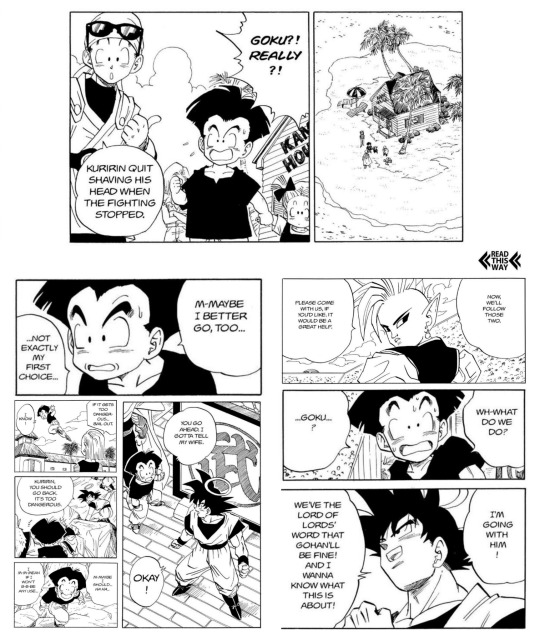
Krillin's depression and PTSD was further shown in DBS as he worked on overcoming these issues.
We didn't see much from Tien besides that he created his own school to train others to defend themselves and protect others. Chaozu is right alongside him.
As for Yamcha, he still had PTSD which is why he didn't fight when Freeza came back. But over time, he started getting back to a positive place in his life and wanted to join Team Universe 7 (but in a rather poor comedic way, he waited to be asked to join but Freeza was chosen instead).
Roshi didn't have the trauma like Krillin & Yamcha do. (I mean he had his trauma from when King Piccolo took over the world hundreds of years ago, but he's had hundreds of years to overcome his PTSD of that without it hindering him much.) But he still had fear becauae of the huge power gap against enemies like Golden Freeza was even greated than what the gap was for the 3 strongest Earthlings. Overcoming depression and PTSD were not something for his character in the Buu Saga nor DBS. His issue was comedy based; a lack of focus when fighting due to having a dirty mind.
#Tenshinhan#Tien#Yamcha#Krillin#Kuririn#Roshi#Master Roshi#Chaozu#Chiaotzu#DB#DBZ#DBS#Earthlings#the depression of Earthlings
42 notes
·
View notes
Text

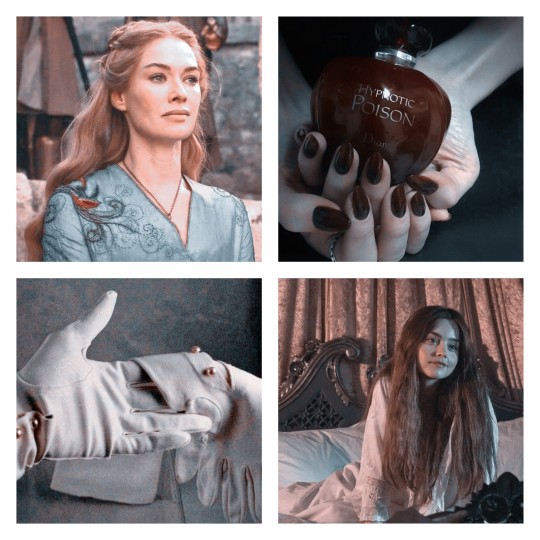
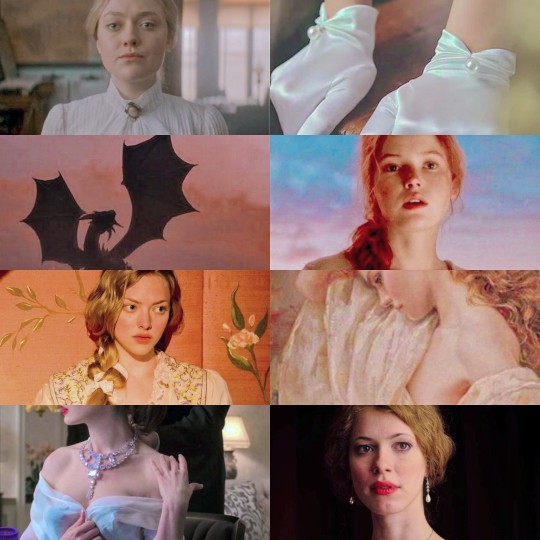

hp women appreciation week, day two; favourite women that are not mine
agata della rovere; she's such an interesting and multi-layered and complex woman, I was besotted with her the moment I saw her @potionboy3
gaia alden; I know she remains a mystery but she's my emmie's descendant and i'm also in love with the concept of her and olympia (make them a couple challenge!!!) @cursed-herbalist
verna malinda; the first character of gryff that I met and I fell for. She's brave, tragic, heroic, and like me, one useless lesbian. I love her and she remains in my loml list @gaygryffindorgal
astraea mckenzie; she's beauty, she's grace, she's my baby and bestest girl of the founder's era. I fell in love with her and she remains a fav of this era ♥ @magicallymalted
ava campbell: reading book two of tpr made me fall for ava quickly: reckless, badass, with a strong sense of justice and one of the strongest characters of the saga, ava is a well-developed and written character and i can't wait to dive into her stuff @lifeofkaze
ophelia burke; she's such an interesting character, and the true embodiment of abba's 'money money money'. She's cunning, smart and knows how to play the game, and i can't wait to see the last part of symphony @the-al-chemist
brianna o'rourke; she's an underrated baby, someone i highly relate to and her character alone without her li is so interesting and fun to read! A comfort character of mine @unfortunate-arrow
virginia scott; another underrated b!tch, she's literally what i aspire to be someday, not to mention an instant crush and fav, she deserves to be in this list @slytherindisaster
adelia selwyn; a crush of mine before i came into the fandom (and later inspired me to join it!) Her beauty matches her intellect and she's one of the most all-time iconic women of the era. This legend is worthy to be here @thatravenpuffwitch
siobhan llewellyn; ofc shiv should be here!!! she was another of the inspos to join here and one of the first ocs i interacted, as well as her owners. She's badass, with a soft side, funny and witty, same goes for her owner 🤍 @kc-and-co
odette bellerose; yet another underrated baby, she's literally living my dream: live in marseille in a big ass mansion in late victorian england. she's such a complex and interesting character, she deserves to be here @kathrynalicemc
miriam cairncross; of our brokencross universe, miriam was the first lady i was introduced to and she was an instant fav!! She always shows that she's not just eli's wife and is interesting in her own right. She deserves to be here as well @cursebreakerfarrier
mathilde coventry; a recent one, she's such a badass as well! Poisoning her way through everything and ofc her special relationship with my bruna is one of the best girls out there @camillejeaneshphm
abbi bennett; ofc i had to put my wife here! She's one of the best characters, and alongside roxie, is a fav of mine. I'm forever thankful that you chose her to be ernest's wife 💜 @mjs-oc-corner
#hpwomenaw#agata della rovere#gaia alden#verna malinda#astraea mckenzie#ava campbell#ophelia burke#brianna o’rourke#virginia scott#adelia selwyn#siobhan llewellyn#odette bellerose#miriam cairncross#mathilde coventry#abbi bennett#myedits*#mine*
28 notes
·
View notes
Note
whats the good comics to read? ive read & liked hellboy & flex mentallo, watchmen was pretty good. did not rly enjoy punisher that much tho i read a lot of it like 15 years ago. ive read a couple of batman runs as well tho aside from killing joke idr which ones.
caveat that I've been mostly reading Marvel stuff of late and I kinda dropped off comics like...a month and a half ago or so cause of work and pivoting to interest in film, though I'm hoping to get back into it. But here are some things I've enjoyed!
The original Stan Lee and Gerry Conway Amazing Spider-Man runs are great if you want old-school character drama and have the patience for excessive exposition. The same caveats go for Chris Claremont's tenure on Uncanny X-Men which are some of my favorite cape comics ever. This run is really long, so if you want a condensed idea of what it's like, "God Loves, Man Kills" is a great graphic novel that kinda captures the spirit of that era and its core characters, and I also adore the Starjammers/Brood Saga. The New Teen Titans by Marv Wolfman, which @radiofreederry is chronicling as she reads it, works for similar reasons as Claremont's X-Men, which it was emulating and in some ways surpasses.
J. Michael Straczynski's Amazing Spider-Man run...there are two options here: 1) Just read the period where John Romita Jr. is the artist, which ends with "The Book of Ezekiel" arc. This is the strongest and most consistent section of the story. It actually made me cry at least once or twice. 2) Read the whole run, but recognize that it *will* shit the bed at least three times, two of which are mostly pointless and skippable ("Sins Past" and "The Other"), one of which is both one of the worst stories ever told and fundamentally damaged the character to this day, *and* the unfortunate, editorially imposed conclusion to the whole creative run ("One More Day"). However this section also includes two of my favorite Spider-Man stories ("Mr. Parker Goes to Washington/The War at Home," imo the only part of Civil War that actually proved the value of the event, and "Back in Black") so it depends on your patience and willingness to deal with wack stuff in order to get to good parts.
Mark Waid and Mike Wieringo's Fantastic Four run is like, really charming and beautiful and silly but moving. Honestly a perfect run imo.
My favorite Batman story is unquestionably The Long Halloween by Jeph Loeb and Tim Sale, which was a big influence on the Matt Reeves Batman movie (which is also my favorite Batman film). Really embraces the character's detective qualities, which is when I think he's most interesting - I don't need him to be doing a lot emotionally or be the most unconquerable creature with tons of prep time, I need him to be Hercule Poirot in a silly suit. But if you want a great detective story without Batman's baggage, Denny O'Neill's The Question is so so good. Funny, dark, politically charged, philosophically poignant. Kind of ends unsatisfactorily but the ride there is really good detective drama.
If you like Hellboy, it's worth checking out a lot of the late 80s DC/Vertigo lineup which aimed for weirdness and high concepts. This includes Alan Moore's Swamp Thing, Gaiman's The Sandman, Hellblazer, Animal Man, and Doom Patrol. Double-recommendation for Doom Patrol and Animal Man, because both were written by Flex Mentallo author Grant Morrison.
Let's see...George Perez's Wonder Woman is a cool mix of grounded drama and high-fantasy. I like it best when Perez is on pencils and writing, not just the latter. Hawkworld is the only good Hawkman story. Morrison's All-Star Superman is great but requires a lot of Superman familiarity to really appreciate imo. Warren Ellis's time on Thunderbolts is a fun little action/psychological thriller comic. Brian Michael Bendis' Dardevil is actually really good, it's the only thing he's written that I think is great without any qualifications. Gail Simone's Secret Six is a fun variant on the Suicide Squad concept. I like 2000s She-Hulk, Ghost Rider...the first forty-two issues of Ed Brubaker's Captain America is honestly a pretty sick spy thriller.
if I didn't' mention something well-regarded or contemporary here (e.g. Mark Waid's The Flash) assume I just haven't read it yet, I have an extremely long spreadsheet of things to read. This got pretty long but yeah, that's a bunch of stuff I've read and enjoyed!
7 notes
·
View notes
Text
There are so many understatements and untold stories in these Twilight movies and books, it's driving me fucking crazy. But purely for the sake of my own headcanons and fictional characters, as well as the lack of information in some parts of the saga, I did a study:
So, I tried to dig up more about who these two chicks are:

If you've watched movies 100 fucking times and still haven't noticed them, then that's absolutely alright.
But if you suddenly do a photo search in Google, then you will be shown the results of something like: Volturi, Sulpicia, Athenodora and other similar shit.
If you are some kind of Twilight nerd, then you probably know that these are the same ladies who, according to the books, have been sitting for centuries in that drug tower.
They look pretty good for that lifestyle, but since they're vampires, it's ok☻️
Most believe that the white one with the perpetually confusing expression is Athenodora (Caius' wifu), and the taller one with the poker face is Sulpicia (Aro's one).
They have absolutely no backstory. It is only known that when Caius met Athenodora, she seemed to be already a vampire. So she may be older than him by many centuries (or not). Sulpicia was found and turned on his own by Aro, according to the book (or guide) she was a young orphan (although in the film she is already a grown-ass woman).
Since not a damn thing is written about them anywhere, one can guess from the names that Sulpicia probably lived in antique Italy (Rome). The name Athenodora is Greek (a gift of Athena, I believe), and it can be assumed that she lived in Attic Greece.
Then, there are the facial expressions of these two throughout the film:
Athena "Blondie's"👇 Suli "Brunette's" 👇
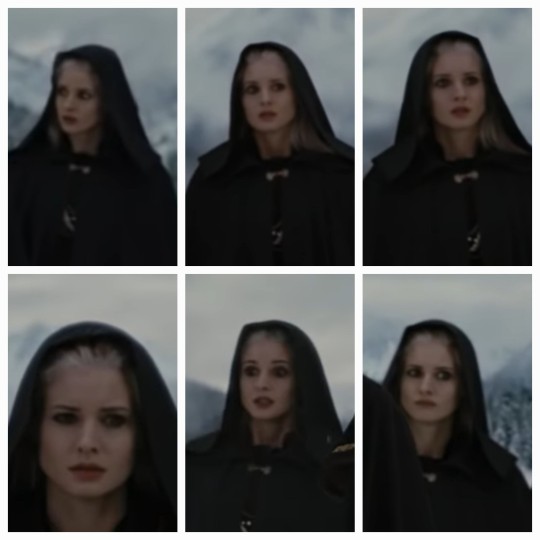
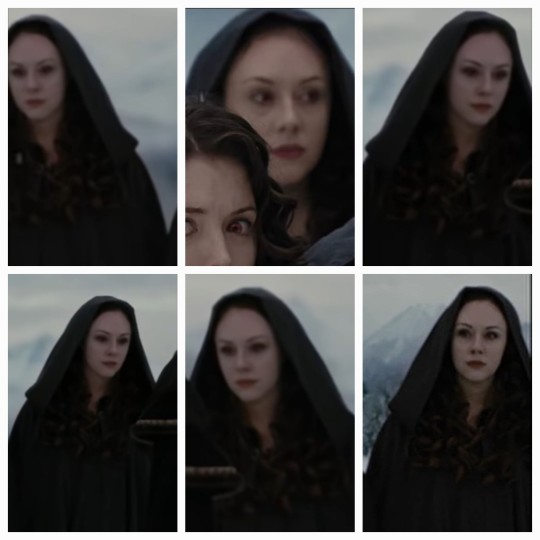
See the difference?
Sulpicia hardly gives a shit about what's going on and stares at the snow most of the time.
Then, there is Athenodora who is ready to have a heart attack from what she saw.
Bitch just look! 👇
Athena's strongest emotions
throughout the battle: and this damn Suli's

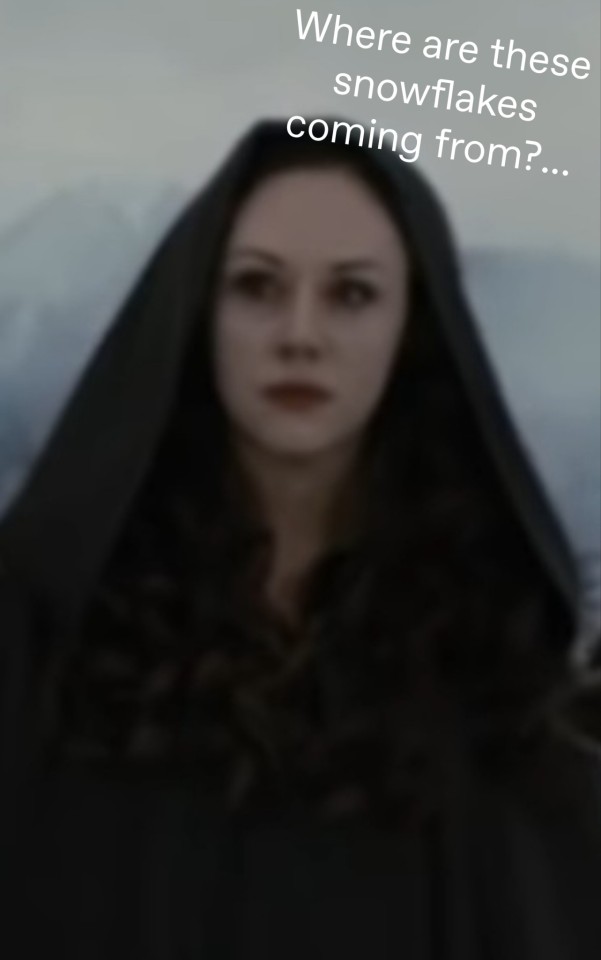
Girlie probably haven't seen snow in 500 years.
It is also worth noting that of the two, Athenodora is the only one who is even a little worried about what is happening:
Sulpicia *I'm a statue, bitch.*
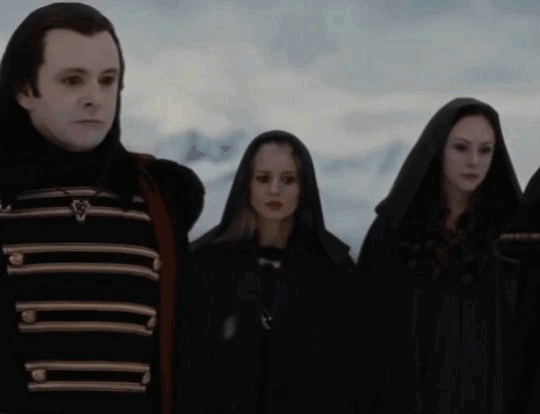
So, the difference in their emotional levels is pretty obvious.
The next step is appearance.
The difference in their hair color and facial features is already seen, so I would like to answer a more interesting question: How tall are they?
Luckily, there is only one scene in the film where Suli is standing next to another background actress whose height is known.
The actress is Rebecca Barras, by the way (she's on the right).
Rebecca's IMDb lists her height as 5'8 (173 cm).
So, with no complicated calculations, it can be determined that Sulpicia's height is approximately 5'9 or 5'10 (about 175 - 177 cm):

Of course, my measurements are skeptical, there is a possibility that the true results differ by a couple of centimeters, but we have at least her approximate height.
Then how tall is Athenodora?
Again, fortunately for us, there are shots where they stand shoulder to shoulder:

If we take as a basis that Suli's height is 5'10, then Athena's height will be about 7-10 cm less, that is, 5'6 or 5'7 (167 - 170 cm).
Further, what else can we find out from those miserable two or three scenes with these two women?
In fact, you can slightly predict their relationship with their husbands and even with each other:
First, a rather remarkable thing, Sulpicia almost never looks at Aro. Athenodora mostly looks at him:

In fact, some may speculate that she is Aro's wife and not the woman disguised as a lamp next to her, but I have reason to deny this theory (and this would also be a very important point between these two girls that many missed)
And I'm talking about this small scene:
Y'all see that shit?
Y'all see that tiny push? 💥👊
Also, follow Sulpicia's gaze after that damn push.
This, it turns out, is the first time she has looked at her hubby in all the fucking time of the battle!
Because Athena wanted her to do it.
This also confirms that the brunette is indeed Aro's wife, because why the hell would Athenodora draw Sulpicia's attention to her own husband?
And secondly, it shows a little bit what kind of relationship they have.
Since they spend together supposedly 24 hours a day, 7 days a week in the tower alone, they don't need many words to understand each other.
Maybe eye contact will suffice?
And here I am talking about this:

Why is she looking to the left??
Do you all recognize this scene? This is the scene where Aro is dramatizes, something like "If we don't fight today, we'll die tomorrow" or something like that.
And all the witnesses are looking at him. Even her bodyguard (behind her). But she looks somewhere strongly to the side. And if you watch the scene to the end, you will see that she does not look away. What is she staring at?
And you will find the answer in the photo above this. I marked the starting positions of Sulpicia and Athenodora. Before the start of the battle, Suli with her bodyguard walks on the left, and Athena with hers walks on the right. From Sulpicia's pov, Athenodora is standing to her left (and quite far away).
So, according to my assumptions, she could very likely be looking at Athenodora.
There is another suggestion that she is looking at Caius, but he is not that far to the left in this scene.
And, after all this endless chatter, I would like to answer the main question about these two ladies...
.
.
.
Are they fuckinn in that tower of theirs?🤔
Hell, who knows!
They spend so much time together (they are guarded of course, but I doubt that the guards are watching while they change their underwear or some other shit), the same goes for Corin. Most likely she is with them only when necessary, right?
So! The hell are they doing there? Looking at the wall? Mm, doubt it.
I don’t know if their husbands pay them visits, but at least they should have some dildos (have a little conscience😮💨)
Or else, when they get bored, they can help each other with this.
I don’t know if it’s just a necessity or they really have some feelings for each other (maybe it’s just my fantasy), but when they appear together in any scene, their capes touch a little👀
#the twilight saga#twilight#Ancient lesbos are what we miss in Twilight#the volturi#Bitches are gay af i see by their eyes#SMEYER ANSWER OUR QUESTIONS
62 notes
·
View notes